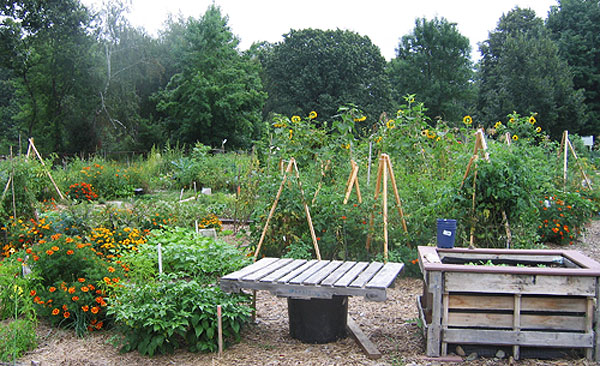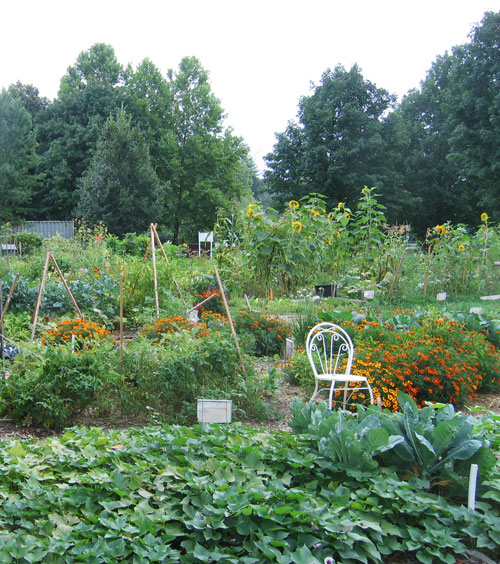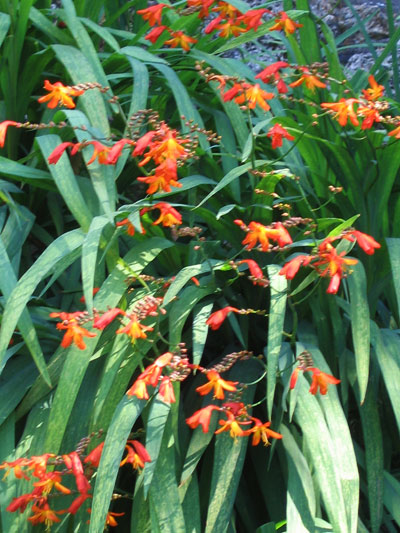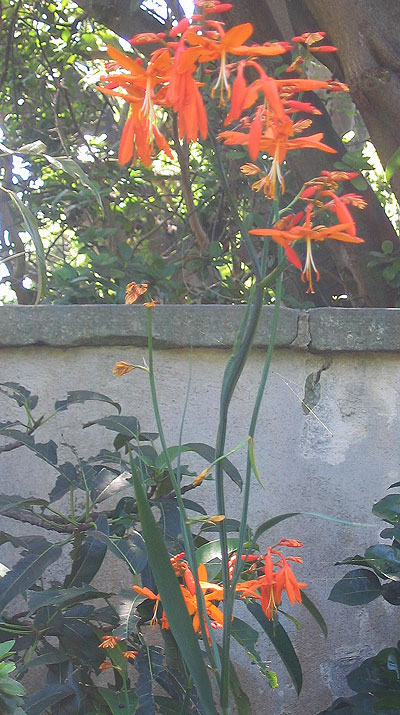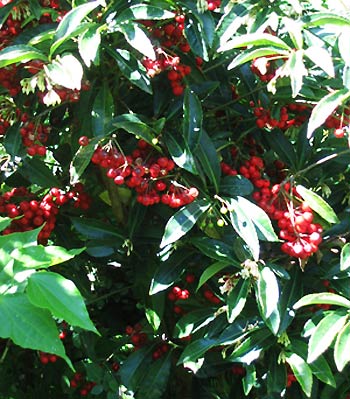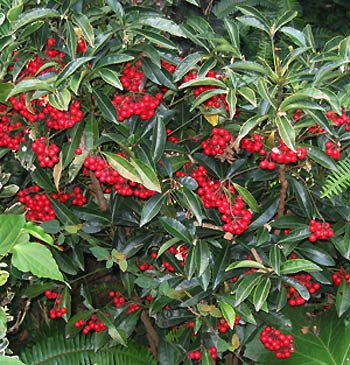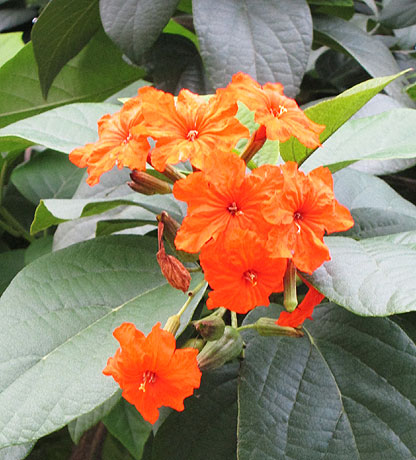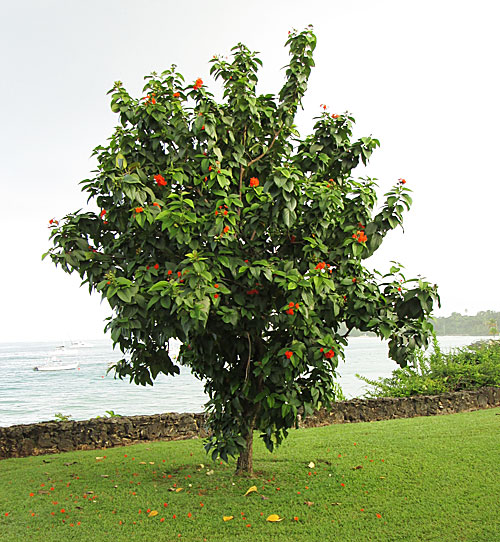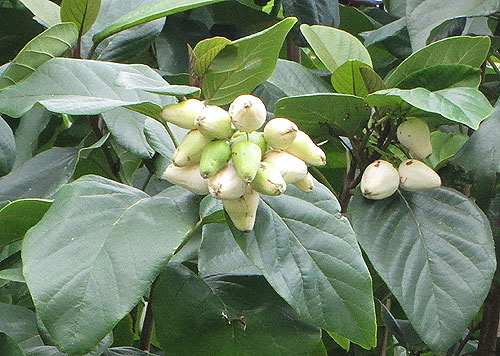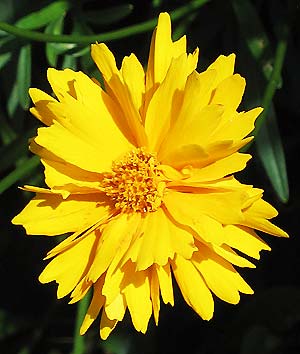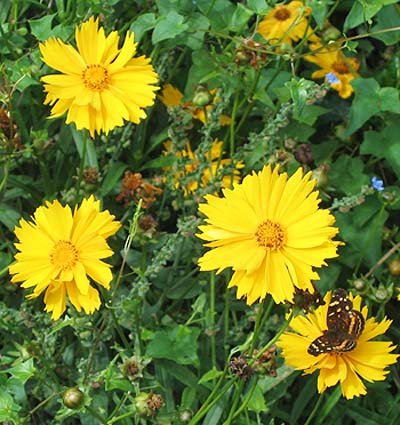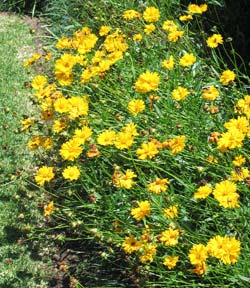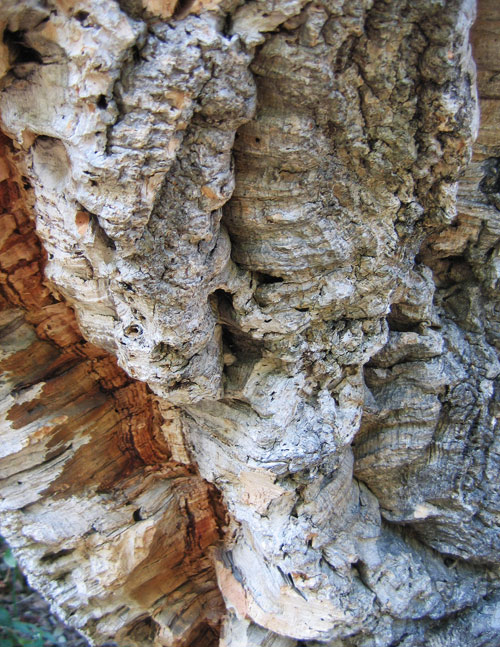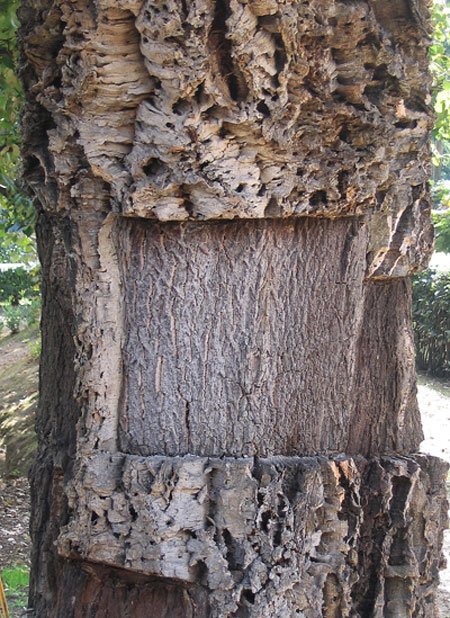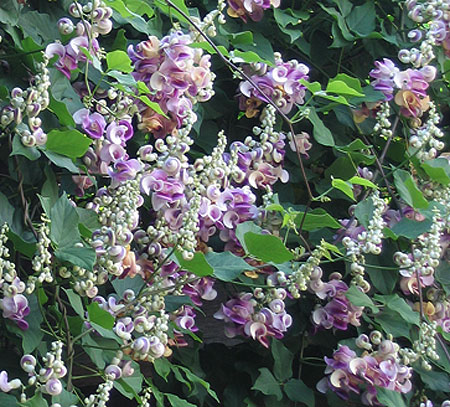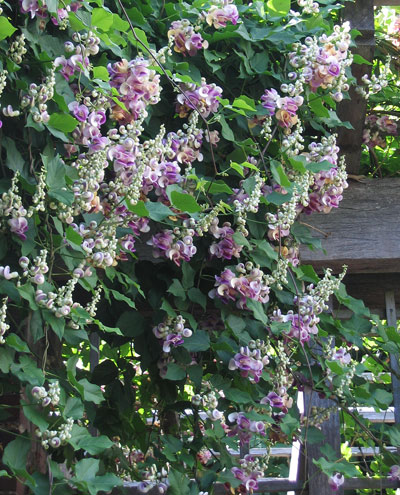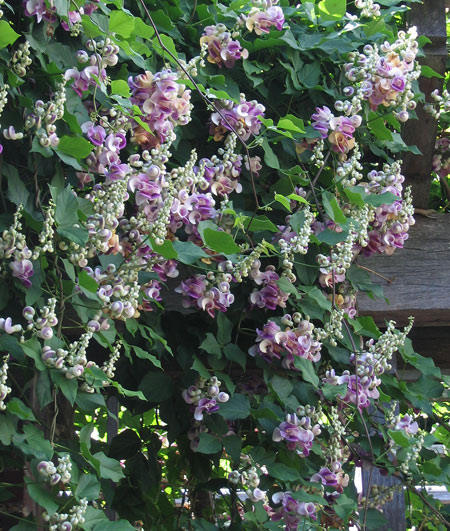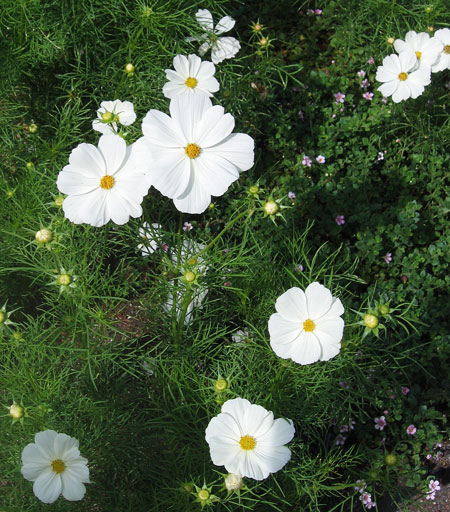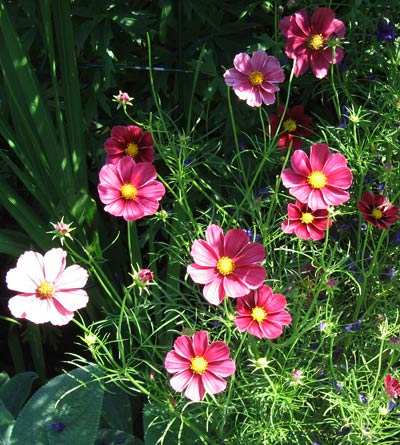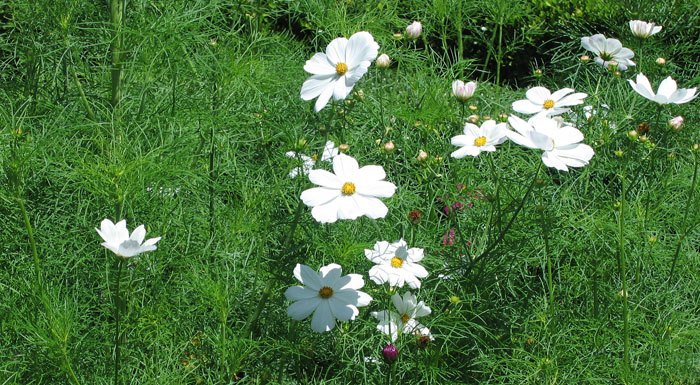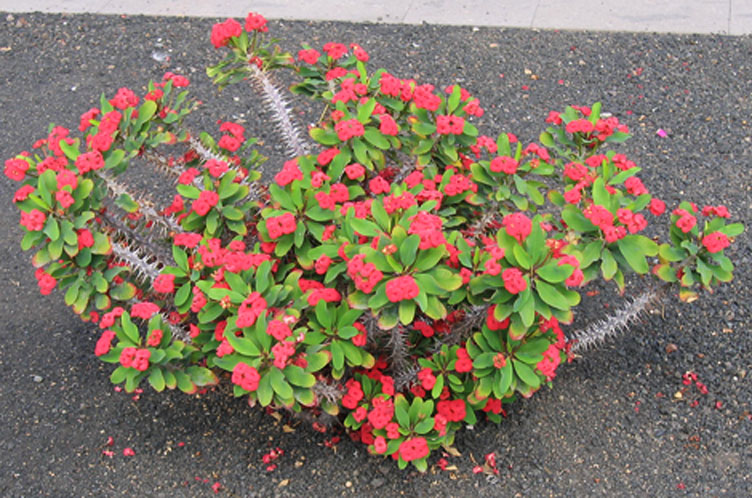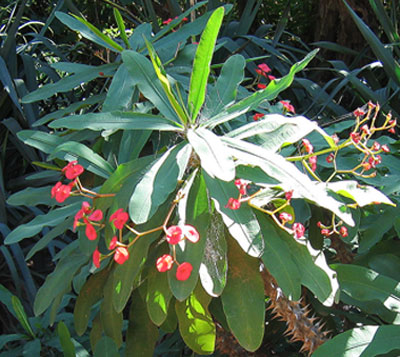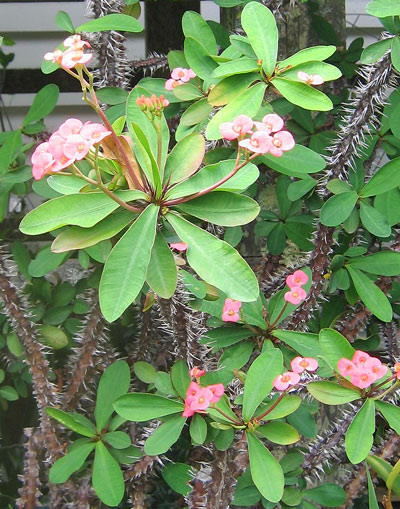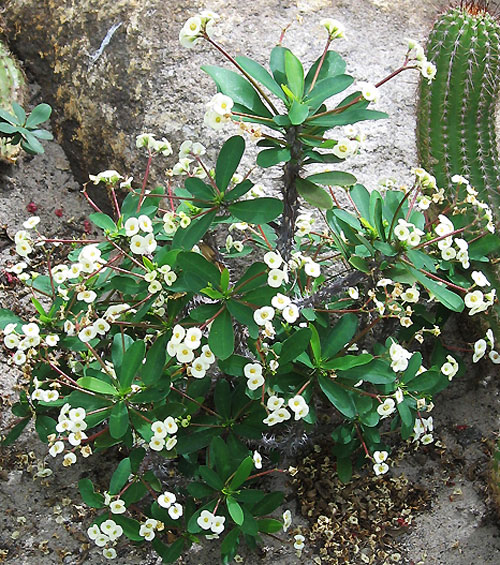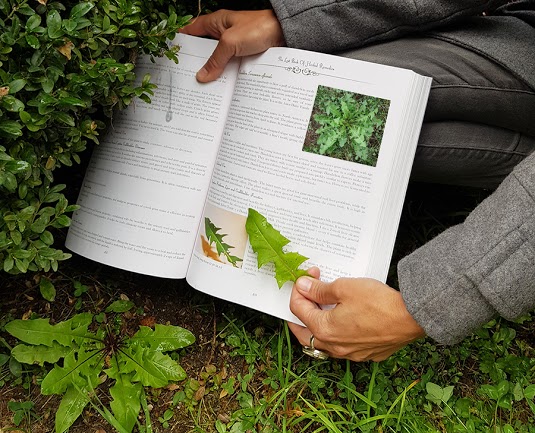| GreenGardeningCookingCuring.com | C
PAGE |
Twe |
| HOME |
| Tour Our Destination Websites | Taxco-Today.com | Oaxaca-Today.com | Montserrat-Today Site |
| See our silver designs at Krika.com | Read our travel stories and other tales at Krika.com |
|
|
CABBAGES |
||||
 **Cabbage,
Green Brassica oleracea **Cabbage,
Green Brassica oleraceaCabbage is a wonderful and very adaptable vegetable; use it in salads, soups, Chinese egg rolls and more. But, it seems to me that the flavor of cabbage really requires growing in a cool or cold climate. Those that I've tasted that were grown in the Caribbean just weren't worth eating, even the ones we grew one year in our own garden in Montserrat fell short of what we were expecting. Benefits: Cabbage is in the same general family as broccoli and cauliflower. All of them provide similar benefits and nutrients. Prepared fresh and creatively they are all delicious and serve well as what my mother always called "roughage," something the digestive system requires to be healthy. Like just about everything green, cabbage has lots of Vitamin C, but also Vitamin K which helps blood to coagulate if you have a wound and plays a role in bone health as well. Photographed: In our upper garden at our former home in Montserrat. Planting and Care: Although I can't recommend cabbage planted in a warm or tropical environment, if you wish to do so start your seeds in a small movable seed bed where the emerging plants will be protected from mid day sun. Keep the soil moist and use liberally a liquid fertilizer like Miracle Grow. Transplant to the garden when starter plants are about 4" tall. Plant them in good compost rich soil and get ready to combat the bugs and caterpillars with hot pepper or neem sprays. Text & Photograph ©GreenGardeningCookingCuring.com 2014/2018 |
||||
| Red
Cabbage Brassica oleracea Benefits: Apparently red cabbage shares some of the same remarkable benefits that we find in blueberries. It is also said to be much more beneficial than green cabbage in reducing the risk of cancer. From: Europe Photographed: Not yet. Planting and Care: Start your seeds in a small movable seed bed where the emerging plants will be protected from mid day sun. Keep the soil moist and use liberally a liquid fertilizer like Miracle Grow. Transplant to the garden when starter plants are about 4" tall. Plant them in good compost rich soil and get ready to combat the bugs and caterpillars with hot pepper or neem sprays. Text ©GreenGardeningCookingCuring.com 2013/2018 |
||||
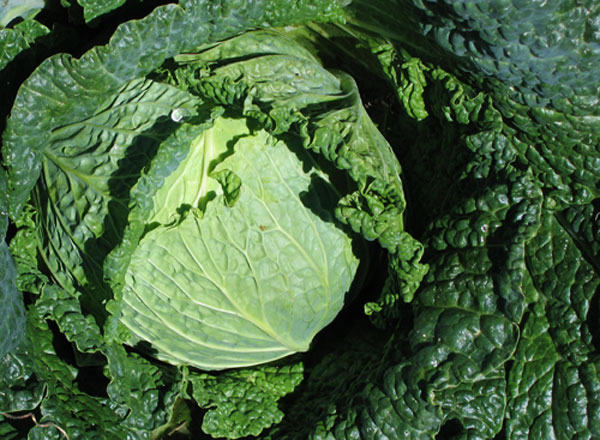 Savoy
Cabbage Brassica oleracea Savoy
Cabbage Brassica oleraceaBenefits: This is a very long list. My recommendation is that if you like it, eat lots of it. From: England and Holland Photographed: At the Blithewold Mansion, Gardens and Arboretum in Bristol, Rhode Island, in 2014. Planting and Care: Plant your seeds about one month before you'll have the last frost in your area. Let your protected seedlings get used to cooler temperatures in the garden before planting. Otherwise pretty much follow the seed packet's directions to have a good crop. Text and Photograph ©GreenGardeningCookingCuring.com 2014 |
||||
**Cabbage Palm Tree Click here to see the -- PALMS AND SAGOS PAGE |
||||
COCOA |
||||
|
||||
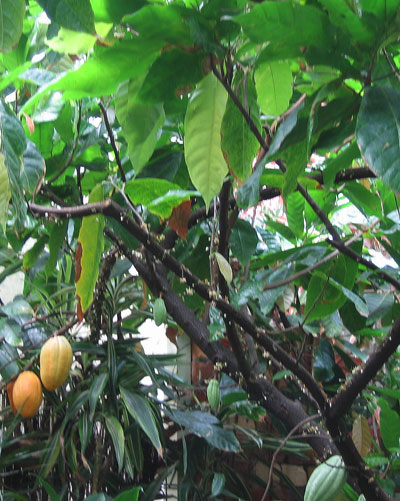 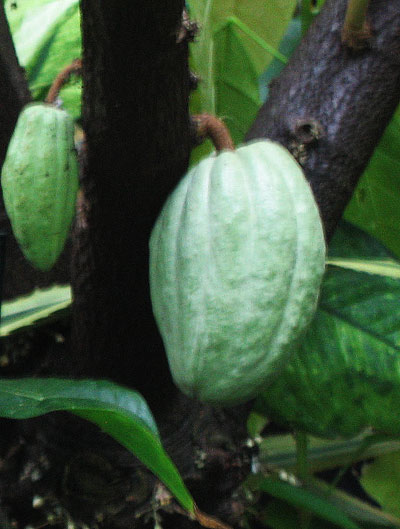 |
||||
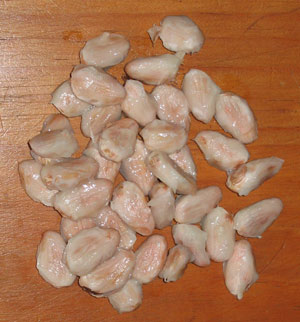 Starting
a cocoa tree from seeds: Starting
a cocoa tree from seeds:This is only for the truly dedicated and maybe a little foolhardy gardener. I didn't try it myself and honestly can't recommend it, but if you have the time and determination give it a try. I'd love to hear how it goes. Once you've opened your pod and retrieved the probably gooey mess inside give them a rinse in cool water to remove as much of the goo as possible. Let the seeds dry and rub with course sand to remove the last of the now papery seed covering. Now comes the tricky part. Place the seeds in a clean glass or stainless steel tray and cover with netting to eliminate the possibility of fruit flies finding the seeds. Keep the seeds moist and warm and shaded. I would recommend using a spray bottle with warm water to dampen the seeds several times a day. Do not let them sit in water. When a small plant emerges place it in a 3 ft wide plastic bag filled with a good composted soil. Put holes in the bottom of the bags for drainage. Leave the little trees each in its own bag for about six months before transplanting them. |
||||
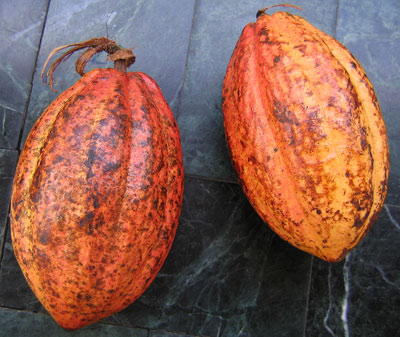 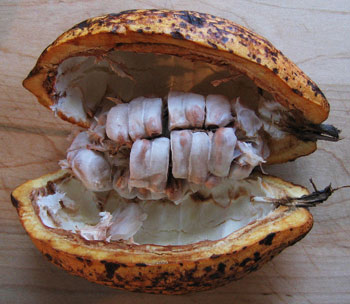 Cocoa
Bean Recipe: Cocoa
Bean Recipe:Toast fresh cocoa beans over medium heat in a Mexican comal or other heavy curved or flat bottomed pan. Remove the seed coating and crush. Mix with minced almonds, fresh grated coconut, sugar and a bit of vanilla or almond extract to make a wonderful homemade candy. Text and Photographs ©KO 2004/2007/2010 and ©GreenGardeningCookingCuring.com 2013/2018 |
||||
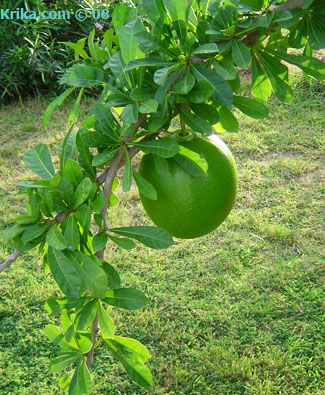 Calabash
Tree Crescentia cujete L. Calabash
Tree Crescentia cujete L.This small not particularly attractive tree produces the equivalent of the North American gourd as you can see in the photographs below. From: The calabash tree is native to the West Indies or to Mexico and Central America depending on what source you have found. It is not a tree that you would choose to have in your garden unless you have a formal public Caribbean botanical garden. Fruits: Treated much like gourds grown in northern climate gardens, the hollowed out dried calabash fruit once served the original Caribbean and/or Middle American populations as dishware, storage containers, musical instruments and more. Today the calabash has become a tried and true staple base for creating Caribbean "tourism product." As a reason for visiting any one of the islands you will see "Calabash Festivals" advertised. These events are product, not "traditional" cultural events; nonetheless, they can sometimes be amusing. In Montserrat in our last few years there, we saw the Department of Tourism devote many of its resources to celebrate its newly created annual "Calabash Festival." Who doesn't come back from a Caribbean holiday without a sunburn and some sort of calabash souvenir? Photographed: At a neighbor's home in Old Towne, Montserrat. Planting and Care: If you wish to have one of these trees, plant it in full sun and water it weekly until it has really settled in. Then sit back and enjoy this very hardy drought tolerant tree. Text & Photographs ©Krika.com 2008 and ©GreenGardeningCookingCuring.com 2013/2018 |
||||
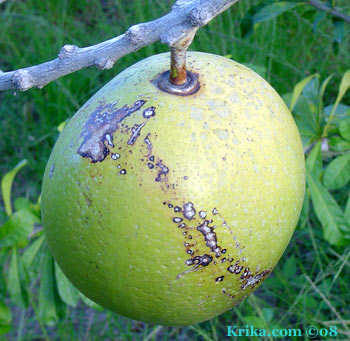 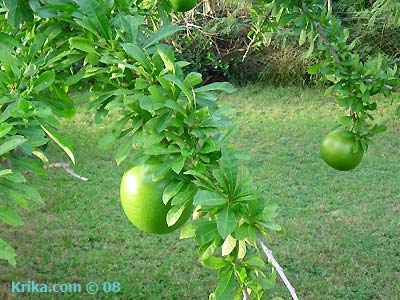 |
||||
|
||||
CALADIUM |
||||
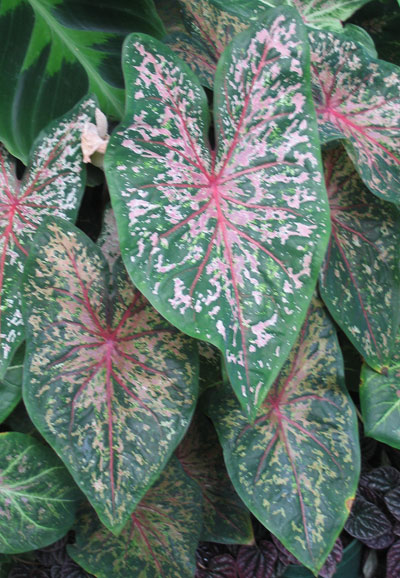 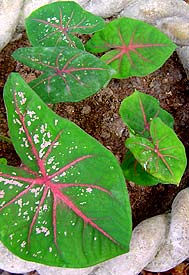 **Caladium Caladium
X hortulanum or Caladium bicolor (Ait.)
Vent. **Caladium Caladium
X hortulanum or Caladium bicolor (Ait.)
Vent. This is a variegated leafy plant often sold as a house plant in colder climates. I had several over the years while living in New England. From: They are said to have originated in South America, but they must also be native or at least natural to Montserrat since they will spontaneously appear here and there when there is continuous rain. We had the common varieties that I have seen and owned as houseplants, but we have one variety that truly seems to have been painted by an artist. It was a gift from good friends leaving Montserrat so we have a special attachment to it. Photographed: To the right and left in our shady terrace garden at our former home in Montserrat. Planting and Care: It grows well in the shadier parts of the garden and seems to be a very hardy survivor. When transplanting one, don’t plant it too deep. It probably will spread of its own accord in warm moist garden areas. Warning: Caladium leaves are poisonous. Text & Photographs ©Krika.com 2008/2009 and ©GreenGardeningCookingCuring.com 2013/2018 |
||||
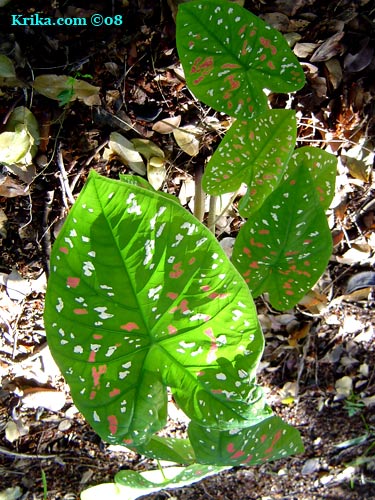 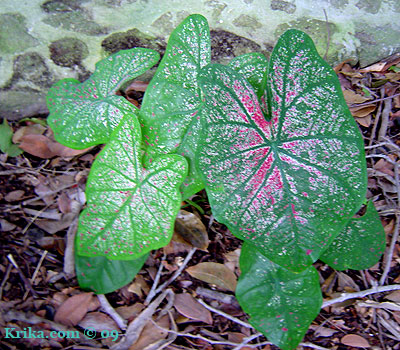 Photographed: To
the right and left in our shady terrace garden at our former home
in Montserrat. Photographed: To
the right and left in our shady terrace garden at our former home
in Montserrat. |
||||
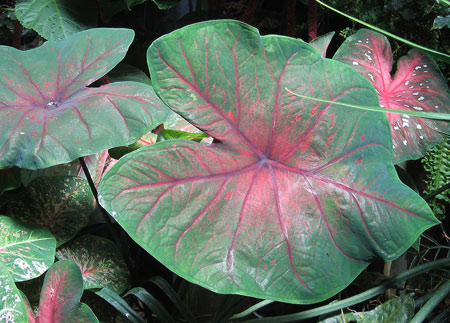 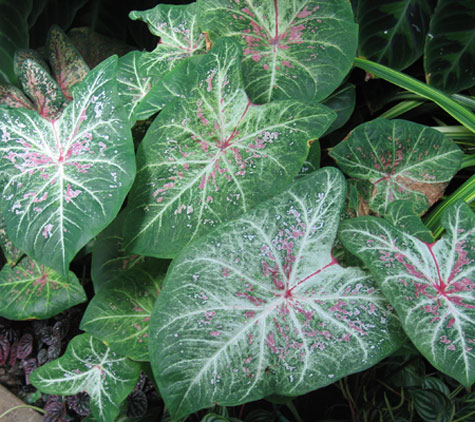 Photographed:
At the Winter Garden in Auckland, New Zealand. Photographed:
At the Winter Garden in Auckland, New Zealand. |
||||
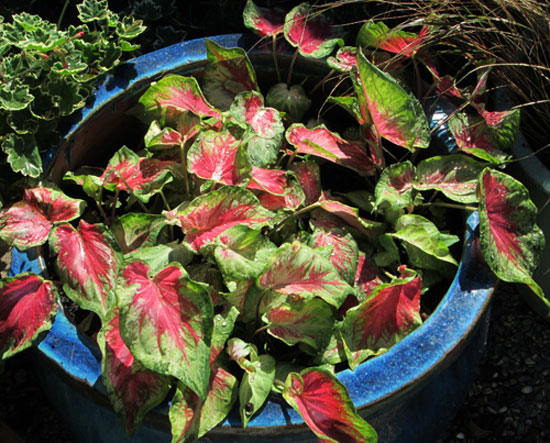 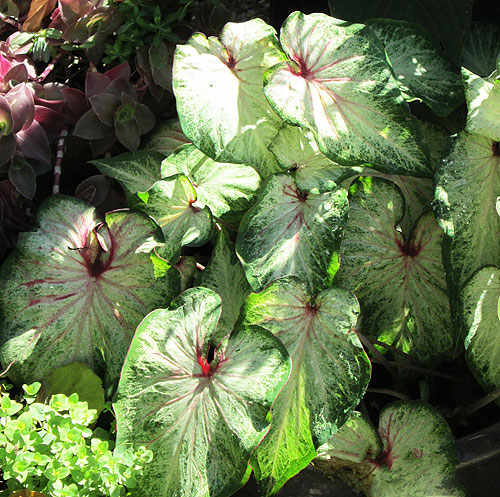 Photographed: At
the Blithewold Mansion, Gardens and Arboretum in Bristol, Rhode
Island, in 2017. Photographed: At
the Blithewold Mansion, Gardens and Arboretum in Bristol, Rhode
Island, in 2017. |
||||
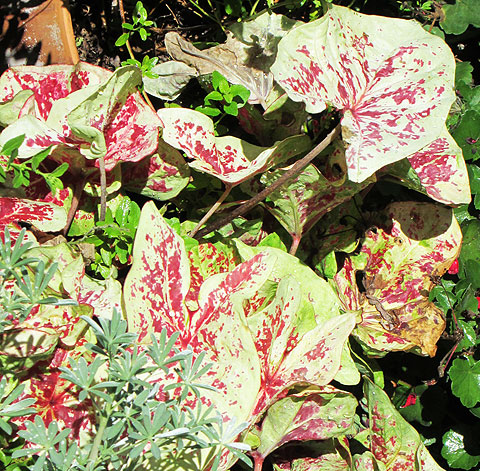 Photographed: At
the Blithewold Mansion, Gardens and Arboretum in Bristol, Rhode
Island, in 2017. Photographed: At
the Blithewold Mansion, Gardens and Arboretum in Bristol, Rhode
Island, in 2017. |
||||
| **Calendula,
Pot Marigold Calendula officinalis This lovely annual plant will flower continually in color shades from heavy cream to yellow to orange. Though they are said to grow to 18" in height, mine have always been more in the 12 to 15" range. Benefits: Not only is the calendula pretty and easy to grow, it also is said to have medicinal benefits both taken internally and applied externally. From: The Mediterranean through to southern Asia. Planting and Care: This is an easy to care for plant that will delight you with its continual flowering. Plant it in a fairly sunny spot in the garden and make sure it receives regular rainfall or watering. Given half a chance it will reseed. Text and Photographs ©GreenGardeningCookingCuring.com 2014 |
||||
 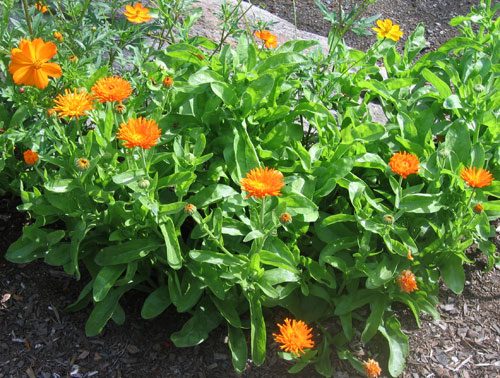 Photographed: On
the left in our garden at Lake Atitlan in Guatemala in 2014 and
on the right at the Coastal
Maine Botanical Gardens, Boothbay Maine,
2013. Photographed: On
the left in our garden at Lake Atitlan in Guatemala in 2014 and
on the right at the Coastal
Maine Botanical Gardens, Boothbay Maine,
2013. |
||||
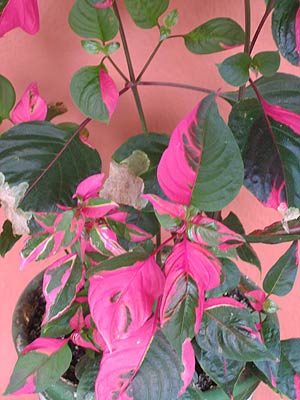 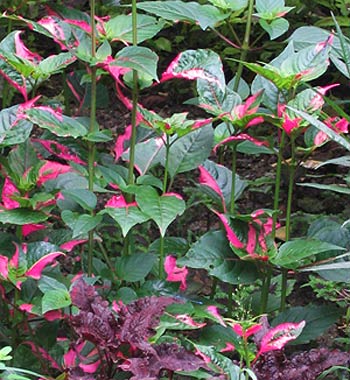 Calico
Plant, Parrot Plant, Joseph's Coat Alternanthera
ficoidea 'Party Time' Calico
Plant, Parrot Plant, Joseph's Coat Alternanthera
ficoidea 'Party Time'Benefits: None that I found. From: Mexico and Argentina Photographed: At the Hotel Atitlan on Lake Atitlan in Guatemala. Planting and Care: This bright and unusual plant will grow in full sun or dappled shade reaching a height of less than 2 feet and spreading from 1 to 2 feet. It prefers moist rich well-drained soil and will appreciate good amounts of rainfall or watering. Text and Photographs ©KO 2010 and ©GreenGardeningCookingCuring.com 2018 |
||||
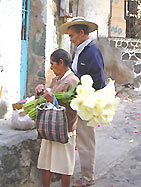 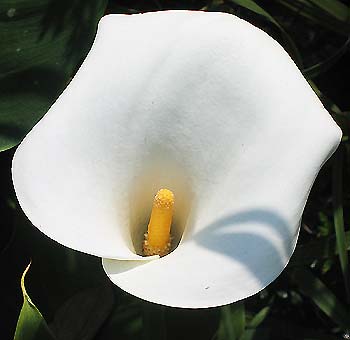 **Calla
Lily Zantedeschia aethiopica or Calla aethiopica **Calla
Lily Zantedeschia aethiopica or Calla aethiopicaCalla lilies are about the most perfectly beautiful flowers in the world and they have been enshrined on canvas by such internationally renowned artists as Diego Rivera. We had them to celebrate our wedding and whenever possible we choose to be surrounded by these most elegant blooms. Benefits and Risks: Do take a little care with them if you have children or plant eating pets as callas are poisonous. From: South Africa Photographed: On the left in Taxco, Mexico, and on the right along the roadside at Hacienda San Buenaventura at Lake Atitlan in Guatemala. Planting and Growth: The calla prefers full sun, but will also grow well in partial shade. Whether in sun or shade it requires lots of moisture. Text and Photographs ©KO 2008/2010 and ©GreenGardeningCookingCuring.com 2014 |
||||
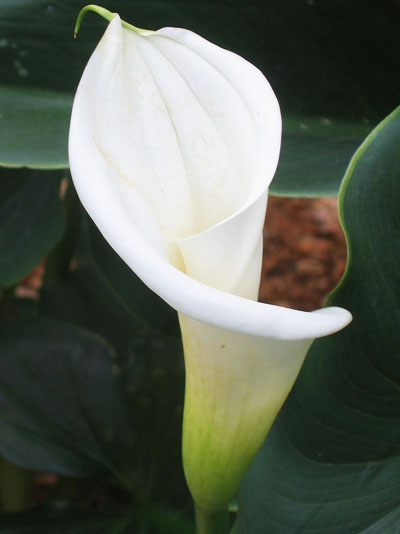 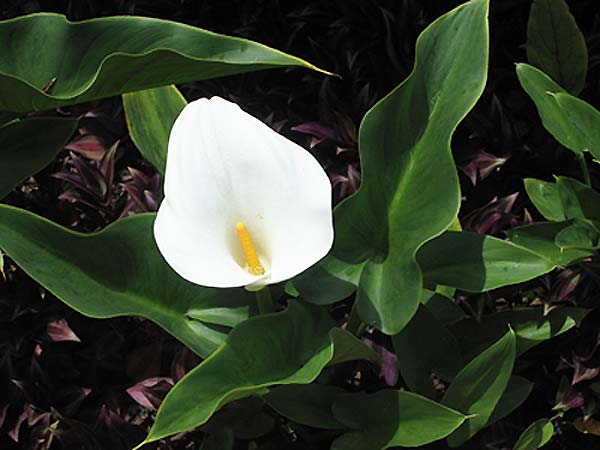 Photographed: In
our garden at Lake Atitlan in Guatemala in 2014. Photographed: In
our garden at Lake Atitlan in Guatemala in 2014. |
||||
| Canary
Island Pine Pinus canariensis Benefits: Oddly enough this is the most fire resistant pine in existence. Its most wonderful benefit is just plain beauty as you can see in the photographs below. From: The Canary Islands Photographed: In the Ortobotanico (Botanical Garden) in Naples, Italy, in 2014. Planting and Care: This is a warm climate pine only. Like me it does not like the cold, any kind of cold. It is tolerant of drought, but will grow 3 feet a year if given a less difficult environment. If you have space and an appropriate climate, buy small trees and get the best local advice from the plant store or from a nearby University. Text and Photograph ©GreenGardeningCookingCuring.com 2014/2018 |
||||
|
||||
|
||||
Candelabra
Bush, Candlestick, Candle Tree, Ringworm Tree, Candle Bush, Empress
Candle Plant Cassia Alata, Senna Alata |
||||
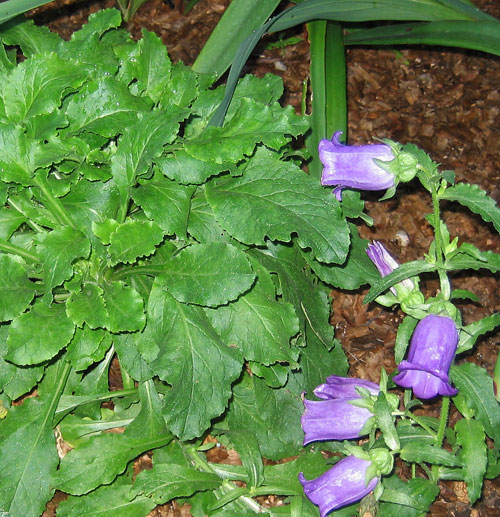 Canterbury
Bells, Bell Flower Campanula medium Canterbury
Bells, Bell Flower Campanula mediumThis charming biennial took until its second year to blossom, but when it did it clearly was worth the wait. If you plant them every year you'll always be able to enjoy them. My seed packet said they might need staking which as you can see in the photograph was a bit of an understatement. Benefits: If you are raising bees for making honey these flowers will make it especially sweet. From: Southern Europe Photographed: In our garden at Lake Atitlan in Guatemala, 2012. Planting and Care: Canterbury bells prefer to grow in a semi shaded part of the garden and they like to be well watered and set in well drained soil. They are said to be not well suited to tropical climates, but if you ensure that they are always well watered and receive only morning sun I think they'll do just fine. Text and Photograph ©GreenGardeningCookingCuring.com 2013 and 2014 |
||||
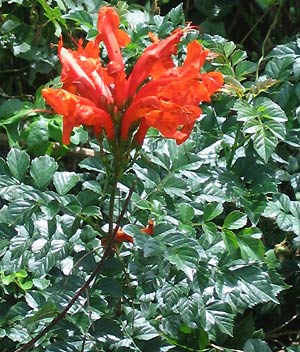 Cape
Honeysuckle Tecomaria capensis or Tecoma
capensis or Bignonia capensis Cape
Honeysuckle Tecomaria capensis or Tecoma
capensis or Bignonia capensisThis is an attractive plant especially because the colors of its brilliant flowers blends perfectly with the deep green of its foliage. Benefits: This is a butterfly and hummingbird attractant. From: South Africa Photographed: In the Botanical Garden at the Hotel Atitlan on Lake Atitlan in Guatemala. Planting and Care: This is essentially an easy care full sun sort of plant. It seems to reproduce or spread freely and I'd recommend pruning/staking or some other sort of containment approach. It will do fine in a situation a bit shy on water. Text & Photograph ©KO 2010 |
||||
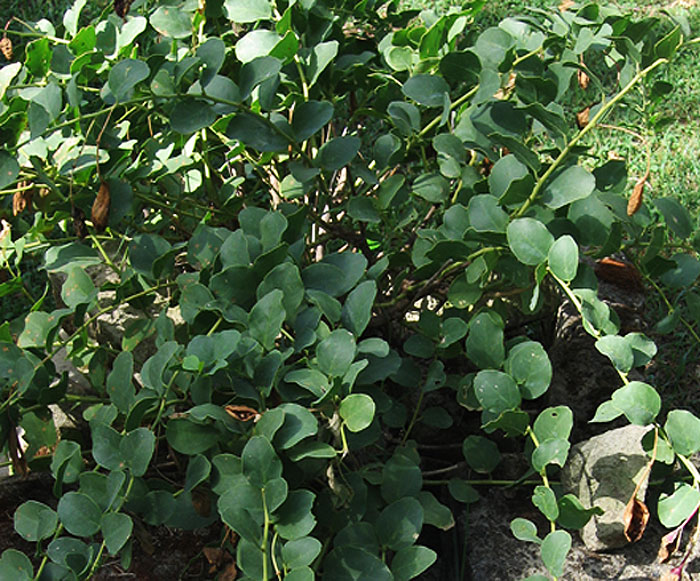 Caper
Bush, Flinders Rose Capparis
spinosa Caper
Bush, Flinders Rose Capparis
spinosaComing from , capers obviously like it hot and dry -- a desert like environment is perfect. The caper bush will grow to be no more than five feet tall and it will delight you with its very pretty feathery purple and white flowers. Edible capers are pickled flower buds; usually the smaller buds are more coveted than the larger ones. From: The Middle East and parts of Asia Photographed: In the (Ortobotanico) Botanical Garden in Naples, Italy, in 2014. Planting and Care: The caper bush grows usually to a height of about 3 feet and it will be about twice as wide when all is said and done. This is a perennial used to pretty harsh growing conditions and if you can match those you should have a very happy plant. Text and Photograph ©GreenGardeningCookingCuring.com 2015/2018 |
||||
**Caraway,
Wild Cumin, Carvies, Carroway Carum carvi or Fructus
carvi |
||||
| **Cardboard Palm See The "P" Page PALMS -- JAIMAICA SAGO | ||||
| **Cardinal Climber See The "M" Page -- MILE A MINUTE | ||||
| **Cardamom Dwarf Shell Ginger See The "G" Page -- GINGER | ||||
| Carpet Bugleweed See the "A" Page -- AJUGA BURGUNDY GLOW | ||||
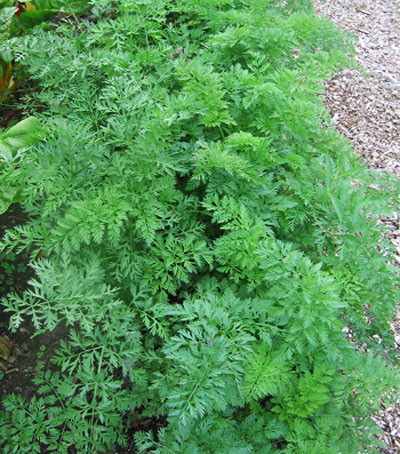 **Carrots Daucus
carota **Carrots Daucus
carotaCarrots are a lovely vegetable and lend themselves to many uses -- cooked alone and served with lemon butter, chopped and cooked as a sweetening base in lentil soup, raw in potato salad for added crunch or grated in cole slaw for color. They are delicious peeled and stored in a cold bag in the fridge for an anytime snack. We had no luck growing them in our garden in Montserrat, but locally grown carrots there were one of the few vegetables that grew very well. I suspect we were using a variety not well adapted to the Caribbean climate. Benefits: Carrots are a good source of the antioxidant beta carotene a type of vitamin A. This is a super skin renewer and bone builder and maybe even an additive to your immune system. Carrots also provide vitamins B, C, and E, and minerals iron, magnesium and calcium. They may also be curatives for kidney and bladder problems, as well as having been used as a treatment for lower intestinal parasites. From: Europe and parts of Asia Photographed: In the Blithewold Garden in Bristol, Rhode Island 2013. Planting and Care: Carrots were difficult for us to bring to harvest in the Caribbean. There were so many underground pests and such typically heavy soil that we had no luck at all. The one time they were off to a good start, feral chickens dug them up. Like so many other vegetable plants, carrots require full sun and an even amount of watering. Insects are not generally a problem above ground. And if you run into the same problems that we had, consider growing the other very orange vegetable, sweet potatoes. They grow like weeds in a hot climate and require very little care. Special note: When you harvest your crop, cut off the leafy tops and the carrots will last longer in storage. Text ©KO 2008/2010 and photograph ©GreenGardeningCookingCuring.com 2013/2018 |
||||
| **Carroway -- See Caraway above | ||||
| **Caruba See The "B" Page -- BANANA PASSION FRUIT | ||||
| Carnations Dianthus
caryophyllus Benefits: Who would have thought these flowers were edible? They'll add a spicy flavor and visual appeal to your salads as do nasturtiums. Use only flowers from your organically managed garden to avoid any unwanted pesticides or other noxious chemicals. From: The Mediterranean Photographed: Not as yet, but I'm on the lookout. Planting and Care: Carnations like a well-drained, neutral to slightly alkaline soil, and full sun. Normally this flower will be no taller than one and a half feet and you can buy annual or perennial varieties for planting. They are frost hardy, but require a 4" mulch to see them through the winter. Text Copyrighted ©GreenGardeningCookingCuring.com 2013/2018 |
||||
| **Carvies -- See Caraway above | ||||
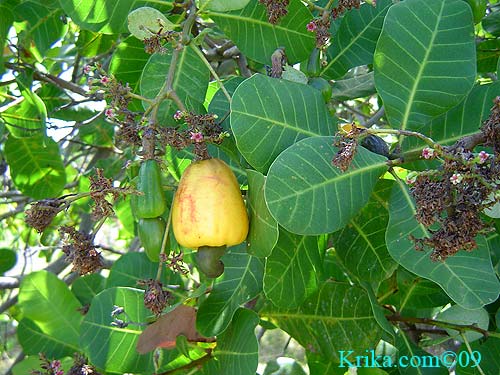 **Cashew
Tree Anacardium
occidentale L. **Cashew
Tree Anacardium
occidentale L.In Montserrat and I suspect in most of the Caribbean the cashew tree is called a cherry tree for its unusual fruit, a three inch or so shiny soft red or yellow pear shaped fruit which is eaten fresh and used in local soft drinks. While hanging from the tree, the fruit bears a cashew encased in a tough fibrous covering at its end. These seeds are harvested, toasted and the covering carefully removed to get to the delicious nuts. Benefits and Cautions: Along with the mango, this tree is a member of the poison ivy family with the same potential to give you a nasty skin problem. The hulls of the cashew nut contain cardol oil which blisters the skin and is very toxic. This poisonous oil is used externally in the treatment of skin infections, herpes lesions and to heal warts and corns. The bark has been used in the treatment of an assortment of diseases – from diarrhea and diabetes to some of the symptoms caused by syphilis. Aside from being truly delicious, cashews nuts are 15% protein, 40% oil and high in Vitamin C. From: Native to tropical America, the cashew has now spread throughout the Caribbean. Photographed: The yellow fruits above were photographed at a neighbor's home in Olveston, Montserrat, and the photograph below at our former home in Montserrat. Planting and Care: The cashew tree likes it dry and sunny. Depending on conditions, the cashew will grow to between twenty and forty feet, yielding its first crop in three years. Cashew trees go from flower to fruit in just two months. Text and Photographs ©Krika.com 2009/2010 |
||||
|
||||
| Cashmere Bouquet See the "G" Page -- GLORY TREE | ||||
| **Cassia Trees, both Pink and Yellow varieties See the "P" Page -- PINK CASSIA TREE | ||||
**Cast
Iron Plant Aspidistra
elatior |
||||
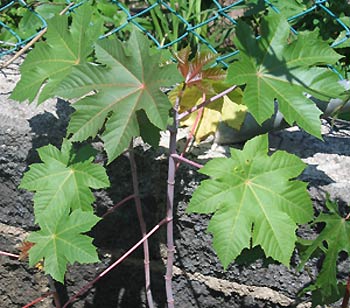 Castor
Oil Plant, Castorbean, Palma Christi Ricinus
communis Castor
Oil Plant, Castorbean, Palma Christi Ricinus
communisThis is a pretty plant because of its appealing foliage more than for its blossoms. It will grow to between ten and twenty feet tall with very little care. Benefits and Dangers: Although the seeds are considered very poisonous, leaves from this plant are commonly used in medicinal cures in South America most probably externally. "If castor beans are chewed and swallowed, they can release ricin, one of the most toxic poisons known to man. Eating just one or two castor beans can easily cause the demise of the eater. Ricin has been investigated as a warfare agent, and has even been employed by secret agents and assassins." From: Africa Photographed: At the Hotel Riviera on Lake Atitlan in Guatemala in 2010. Planting and Care: This plant will do well in full sun or semi shade with only a moderate amount of water. Text & Photograph ©KO 2010/2018 |
||||
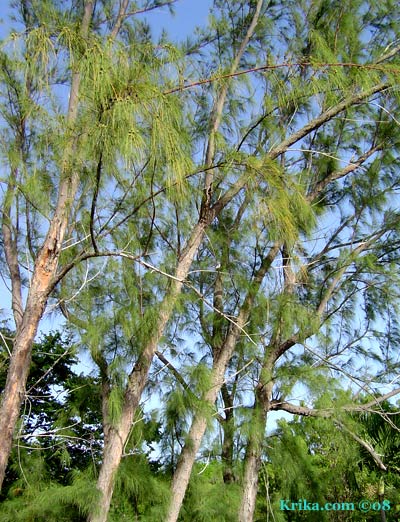 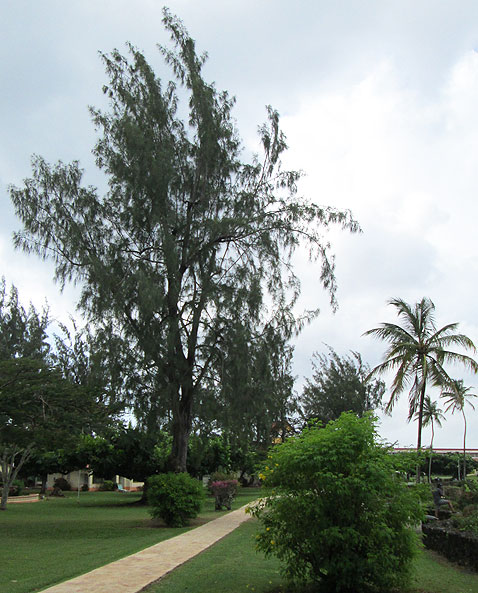 **Casuarina
Tree, Australian Pine, Ironwood, **Casuarina
Tree, Australian Pine, Ironwood,Horsetail Casuarina equisetifolia or Casuarina muricata This is a willowy pine like tree very common in the Caribbean. It is a sturdy survivor of the hot and sunny, windy and stormy and then drought ridden and salty Caribbean island environment. It will quickly grow to be about sixty feet tall and is considered much like the neem tree; nothing lives on it or under it. From: The casuarina is from Australia and other warm areas and islands of the Pacific Ocean. Photographed: On the left at a friend's home in Montserrat and on the right in Crown Point, Tobago in 2018. Planting and Care: These beautiful trees are well adapted to island life. They will do well in full sun, in sandy or other relatively poor soils. I have a particular fondness for them as you may have already figured out. Text and Photograph ©KO 2007 and ©GreenGardeningCookingCuring.com 2018 |
||||
| Cathedral Windows See CALATHEAS above on this same page. | ||||
Cat's
Claw Creeper Macfadyena unguis-cati My #16 Vine Mystery was solved by Glenn a visitor to my website who lives in Brisbane, Australia. Many thanks for your help. |
||||
|
||||
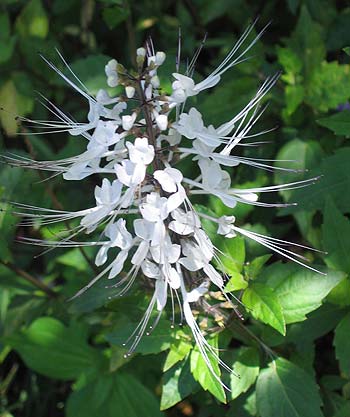 Cats
Whiskers Orthosiphon stamineus, Ocimum aristatum,
Orthosiphon aristatus Cats
Whiskers Orthosiphon stamineus, Ocimum aristatum,
Orthosiphon aristatusCats Whiskers closely resemble cleomes from a distance, but I think they are more interesting when you get up close. I recall that they are about two feet tall or so and the flowers are just what you would imagine when you think of the plant's name. Benefits: Apparently, aside from giving us a bit of beauty in the garden, cats whiskers also gives us medicinal benefits. These plants are also attractants for bees, butterflies and hummingbirds. From: Tropical Australia and Southeast Asia Photographed: In the Botanical Garden at the Hotel Atitlan on Lake Atitlan in Guatemala. Planting and Care: This plant hails from a tropical environment so it is best to keep this in mind when planting this beautiful perennial. Grow it in full sun with a bit of shade and keep the soil always moist, but not wet, and you should have a happy plant. Text and Photograph ©KO 2010 |
||||
| **Cauliflower Brassica
oleracea var. botrytis Benefits: This is one of those cruciferous vegetables that like other members of the family will stand you in very good nutritional stead. If you think cancer is in your future, put cauliflower on your shopping list or better yet plant it in your garden. It is a big plant, so it needs a bit of room, but you won't be disappointed with its taste picked fresh from the garden eaten either raw or lightly cooked. In any case it is a good source of vitamins A and C, along with folic acid. From: Northeastern Mediterranean Photographed: In the Blithewold Garden in Bristol, Rhode Island 2013. Planting and Care: Cauliflower requires full sun with a soil rich in well composted materials. Select a site with at least 6 hours of full sun. You will have more success if you plant seedlings spaced about a foot and a half apart. Text ©GreenGardeningCookingCuring.com 2013/2018 |
||||
| Ceiba Tree See the "K" Page -- KAPOK TREE | ||||
**Celery Apium CLICK HERE TO SEE WHO LIVED IN OUR POT OF CELERY IN MONTSERRAT |
||||
|
||||
| Centipede Plant See the "T" Page -- TAPEWORM PLANT | ||||
**Cereus
See the "N" Page -- NIGHT
BLOOMING CEREUS |
||||
Chamomile |
||||
Chenille
Plant Acalypha
hispida -- Please
see the 'L' Page -- Love Lies Bleeding |
||||
| **Cherimoya See The "S" Page -- SOURSOP | ||||
| Cherries Benefits: Cherries, specifically sour cherries, have now joined green tea and other plants as something that will save your life or drastically improve the quality of your health. I'm not personally convinced that any particular food, beverage or activity has the power to do that. That said, there is probably nothing wrong in enjoying fresh cherries whenever you get the chance. |
||||
**Chickens
in the Garden Recently
we learned from homesteading friends in Oregon that you can
make
a fenced chicken run surrounding your kitchen garden. Bugs won't
get past the chickens on the way to your veggies and the fertilizer
for your garden will be just a few feet away. Not
a bad idea! |
||||
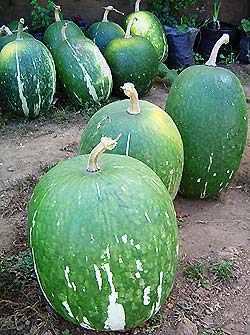 Chilacayote,
Asian Pumpkin, Fig Leaf Gourd Cucurbita
ficifolia Chilacayote,
Asian Pumpkin, Fig Leaf Gourd Cucurbita
ficifoliaToward the end of January 2010 we discovered this huge squash while driving from Oaxaca city toward our beach destination on the southern coast of Mexico, Huatulco. We had taken what might now be called the "least traveled route" over the mountains and we liked it enough to take it again on the way back. Along the way high in the mountains on this narrow and now little traveled road we came to an area where a few villagers were selling plants and flowers beside the road. At this time of year they were also selling chilacayotes. We are going to cook this huge squash while saving the seeds, see if we like the taste and then plant the seeds when we get back home to Montserrat. More later.... Benefits: This is a plant that is currently used to improve the lives and health of diabetics. From: The Americas, though it is now widely spread around the world. Photographed: In San Jose Pacifico, in the State of Oaxaca, Mexico. Planting and Care: In a tropical climate this is a perennial squash and all parts of the plant are edible -- fruit, seeds, flowers and greens. This appears to be like all other squash/pumpkin plants. We're going to see how it does for us. Plant it in a sunny place with a good water supply and it will produce enough to keep you very happy. Text and Photograph ©KO 2010 |
||||
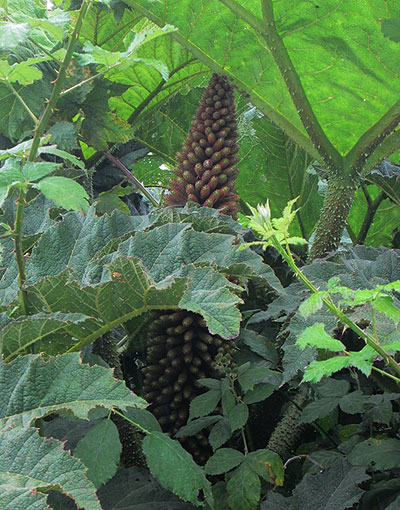 Chilean
Rhubarb, Giant Rhubarb Gunnera tinctoria syn.
Gunnera chilensis Lam., Gunnera scabra Ruiz & Pav. Chilean
Rhubarb, Giant Rhubarb Gunnera tinctoria syn.
Gunnera chilensis Lam., Gunnera scabra Ruiz & Pav.This is a giant version of the more northerly rhubarb, but is not related. Benefits: This pre-historic plant is edible, both stalks and leaves. From: From southern Chile and similar agricultural areas in Argentina. Photographed: At the Sonesta Hotel in Osorno, Chile, in 2019 Planting and Care: This perennial plant grows easily on roadsides and river banks and is considered an invasive plant forbidden entry into the EU. If you do plant it in northerly climates, keep an eye on its seed production to reduce problems with its unwanted spread. The plant is strong obviously and it's also a real eye catcher so you might want to give it a try. Keep in mind its native environment, rich organic soil, sunshine and well drained but moist soil and you'll do just fine. Text and Photograph ©GreenGardeningCookingCuring.com 2019 |
||||
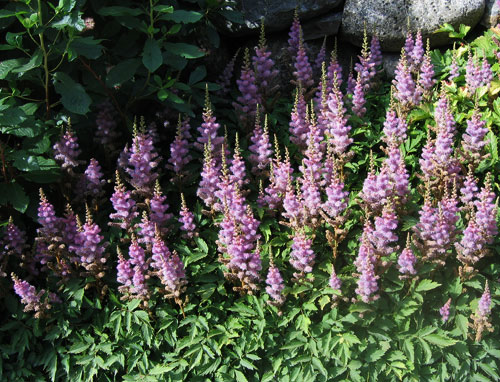 Chinese
Astilbe Astilbe chinensis var. pumila Chinese
Astilbe Astilbe chinensis var. pumilaThis is the low growing variety of a very attractive large perennial shrub. Benefits: From: Tibet and China Photographed: Coastal Maine Botanical Gardens, Boothbay Maine, 2013. Planting and Care: False spirea loves moisture, but in a well drained rich soil. It prefers semi shade or shade even in northern climates. Text and Photograph ©GreenGardeningCookingCuring.com 2013/2018 |
||||
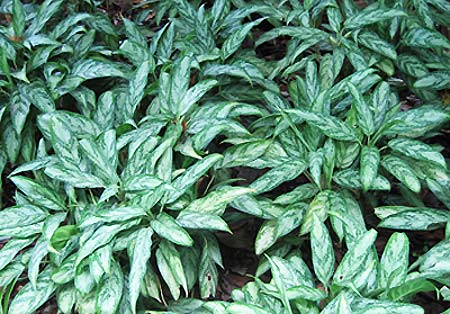 **Chinese
Evergreen Aglaonema
commutatum **Chinese
Evergreen Aglaonema
commutatumThis family of plants is perfect for shady areas of warm climate gardens. The green and white varying pattern options seems almost endless and the plants are easy to care for. From: Subtropics of Southeast Asia Benefits: This is one of the much valued and very easy to grow home air cleaning plants. Photographed: In the botanical garden at the Hotel Atitlan in Guatemala unless otherwise noted. Planting and Care: Growing only to a height of about two and one half feet, this variegated green leafed plant will grow happily in the shade, but it prefers a light soil and a relatively moist environment. Text and Photographs ©Krika.com 2007/2008/2010 and GreenGardeningCookingCuring.com 2014/2018 |
||||
Photographed: In our garden at our former home in Montserrat 2008 |
||||
Photographed: In
the Royal Botanic Garden in Sydney, Australia, in 2013.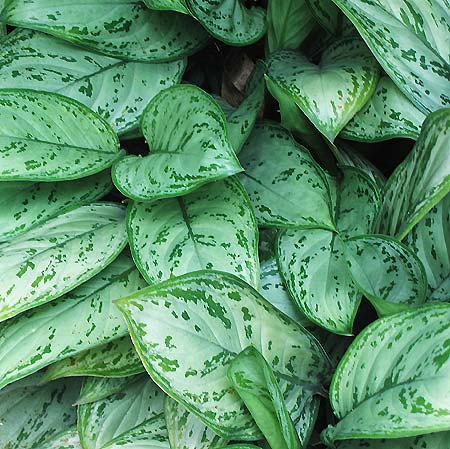 |
||||
Photographed: In
the Royal Botanic Garden in Sydney, Australia, in 2013. |
||||
Photographed: In
the Royal Botanic Garden in Sydney, Australia, in 2013.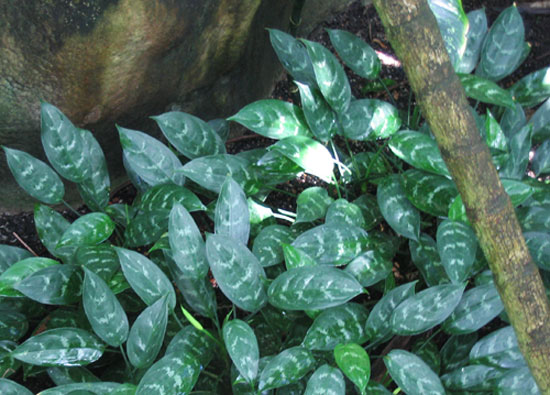 |
||||
|
||||
|
||||
| **Chinese Honeysuckle See The "R" Page -- Rangoon Creeper | ||||
| Chinese Lantern See the "F" Page -- Flowering Maple | ||||
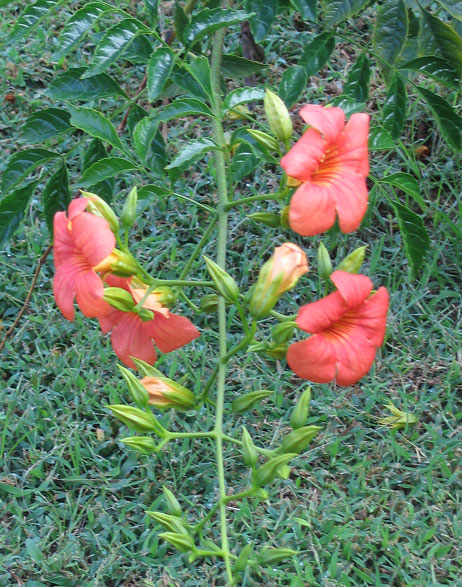 Chinese
Trumpet Vine, Chinese Trumpet Creeper Campsis grandiflora Chinese
Trumpet Vine, Chinese Trumpet Creeper Campsis grandifloraBenefits: The whole plant including its flowers is considered to have medicinal benefits. From: East Asia Photographed: In the (Ortobotanico) Botanical Garden in Naples, Italy, in 2014. Planting and Care: This beauty is a fast growing vine up to about 30 feet that likes to live in warm places. It likes well drained soil, but otherwise isn't fussy about where it puts its feet. It is tolerant of wide ranging pH, but will only thrive in full sunlight with moist, not wet, soil. It might be a very good plant for those of you lucky enough to be living by the sea. Text and Photograph ©GreenGardeningCookingCuring.com 2018 My #4 Flower Mystery was generously solved by Nathaniel, a visitor to the site. I am very grateful for his help. |
||||
Chinese
Violet, Creeping Foxglove, Ganges Primrose, Philippine Violet Asystasia
gangetica To see it living with the spider lilies, please click here. |
||||
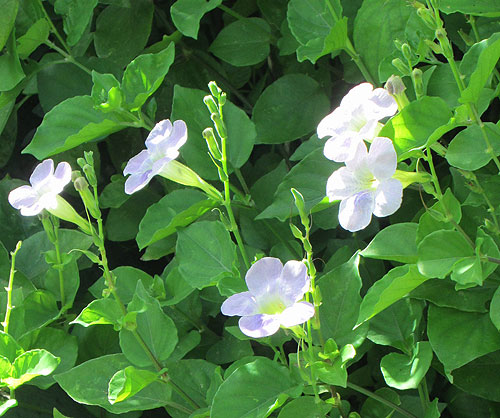 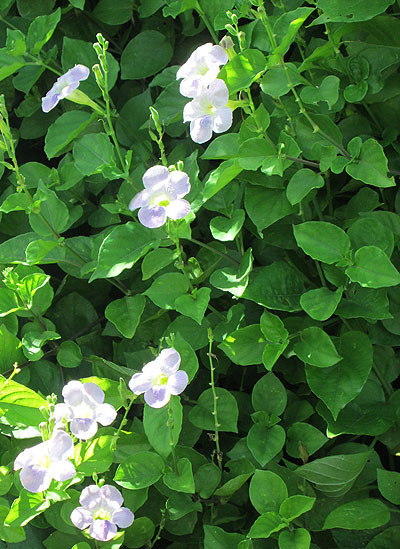 |
||||
| **Chirimoya See The "S" Page -- SOURSOP | ||||
| **
Chives Allium schoenoprasum Who can imagine a baked potato with sour cream and no chives -- not us, so we now have chives growing in the garden and use them liberally on our baked potatoes and lots more. Benefits: The Chinese seem to favor chives as an all around cure all for everything from stomach aches to stuffy noses and, aside from dressing up your baked potatoes, chives do provide enough vitamin C, potassium, folic acid, and iron to make them an valuable addition to soups and stir fries. From: Europe, Asia and North America Planting and Care: Chives are in the onion family and they are perennials so once you get them growing you will be rewarded for years to come. They will grow in full sun or partial shade (especially in a tropical environment) and they like a moist fertile soil. They are ideal for planting somewhere in your flower garden as a border plant because of their twelve inch gray green spiky stems and now and then their small, but pretty lavender flowers. Normally chives are purchased in small clumps ready for planting in the garden. In Montserrat there weren't any such clumps, so we planted seeds and they did just fine. I planted a packet of seeds in our garden at Lake Atitlan a year ago and we are now enjoying them once again. Text and photographs ©KO 2008 and ©GreenGardeningCookingCuring.com 2014/2018 |
||||
|
||||
| Chocolate -- See Cacao Above | ||||
| **Christmas Palm See The "P" Page, PALMS -- CABBAGE PALM | ||||
 **Cilantro,
Coriander, Chinese Parsley Coriander sativum **Cilantro,
Coriander, Chinese Parsley Coriander sativumThe fresh green leaves of cilantro are an essential ingredient in Mexican cuisine as they are also in Indian cuisine. It is a very soft feathery plant that is easy to grow and pretty in a garden row. When the plant matures and produces seeds, they are called coriander, another of the world's favorite flavorings. Benefits: Cilantro is said to enhance your immune system, to aid in digestion and maybe even to help in ridding your body of accumulated toxic metals all of which can't be bad for something that tastes so good! From: The Mediterranean including Europe and Africa extending all the way to the western part of South Asia Photographed: In the upper garden at our former home in Montserrat. Planting and Care: Sometimes cilantro is considered difficult to grow, but I can't imagine why. Soak the seeds in water overnight the day before you will be planting them. Work your soil as you normally would and drop in the seeds. Cover with about one inch of soil and tamp down. Keep watered lightly for the two or so weeks it will take the plants to poke out of the ground and they water regularly as you would just about everything else in the vegetable garden. Text & Photograph ©KO 2008/2010/2018 For a wonderful Caribbean alternative to cilantro See The "F" Page FITWEED |
||||
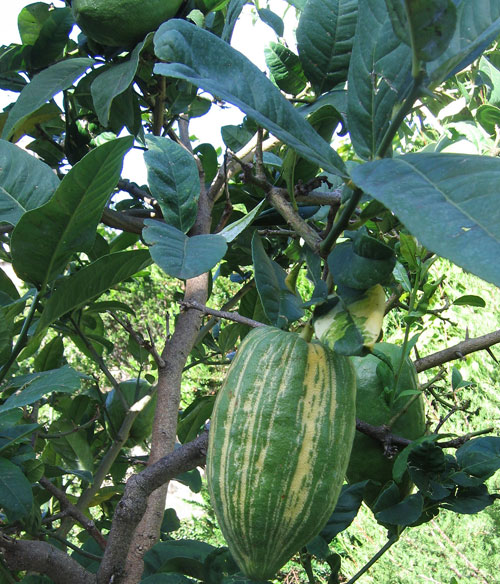 Citron Citrus
medica Citron Citrus
medicaBenefits: Citron has numerous health benefits aside from its use as a flavoring. From: Tropical Asia Photographed: In the Botanical Garden in Naples, Italy, in 2014. Planting and Care: Plant this small tree or shrub in full sun in a warm climate with adequate rainfall or watering to ensure maturing fruit. They like a well drained soil. They prefer full sun, well-drained soil and areas with warm, dry winters and cool summers. Text and Photograph ©GreenGardeningCookingCuring.com 2015/2018 |
||||
Cinnamon
Tree Cinnamon zeylanicum or Cinnamon verum |
||||
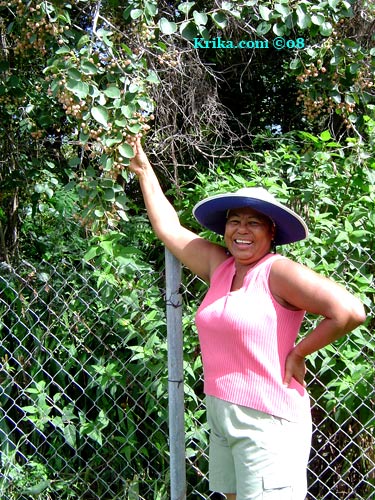 **Clammy
Cherry Tree, Red Manjack Tree, Glue Berries Tree, Snotty Gobbles
Tree Cordia collococca **Clammy
Cherry Tree, Red Manjack Tree, Glue Berries Tree, Snotty Gobbles
Tree Cordia collococcaWe first saw this tree at a friend's house in Montserrat. It was loaded with fruit and we wanted to know all about it. She accommodated us immediately by picking a cherry and popping it in her mouth while talking about having eaten the fruit with her friends when they were school children. Within a minute she had changed her tune as her mouth filled with gluey saliva -- this tree didn't get its name for no reason. From: S. America, Mexico and the Caribbean Planting and Care: This is a weed tree whose seeds are distributed by the Jamaican Fruit Bat. It is unlikely you would want one of these trees in your garden. Link: http://www.batplants.co.uk/clamcherriestext.htm Text and Photograph ©Krika.com 2008 |
||||
| Clematis y Benefits: From: Photographed: Planting and Care: |
||||
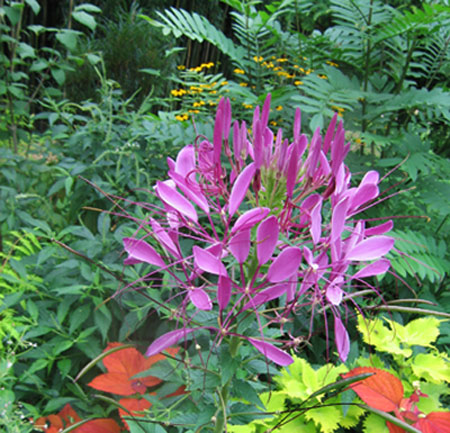 **Cleome,
Spider Flower Cleome hassleriana **Cleome,
Spider Flower Cleome hasslerianaThis lovely annual is easily grown and blooms all summer. Benefits: Bees, butterflies and helpful insects all love cleomes as much as we do. And, there are possible health benefits as well. From: South America Photographed: On the left In the Blithewold Garden in Bristol, Rhode Island in 2013. All others In the Botanical Garden at the Hotel Atitlan on Lake Atitlan in Guatemala, 2010. Planting and Care: Plant seeds in trays ahead of time or seedlings directly in the garden. With full sun or a little mid day shade and regular rainfall or watering, cleome will keep you happy with its blooms atop its attractive 3 to 4 foot foliage. Pests: Aphids, spider mites and whiteflies. What else is new? Text and Photographs ©KO 2010 and ©GreenGardeningCookingCuring.com 2013/2018 |
||||
|
||||
| Climbing Onion See the "O" Page -- ONIONS -- Climbing Onion | ||||
| Clivia Please see Kaffir Lily on the K page | ||||
Cloves Syzygium
aromaticum or Caryophyllus aromaticus or Eugenia
carophyllata or Eugenia caryophyllus |
||||
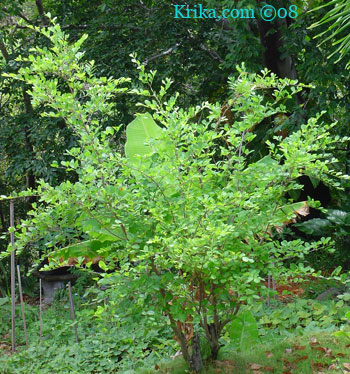 **Coca,
Energy Bush Erythroxylum
coca **Coca,
Energy Bush Erythroxylum
cocaThis is a large open branched bush with smallish leaves that have a pale white stripe down the center. I did not find it to be a particularly attractive plant. Benefits: In Montserrat it is used to steep a tea for an extra bit of energy, hence its local name, the "energy bush." In La Paz, Bolivia, and the surrounding high altitude cities, towns and countryside, older women sit on sidewalks selling dried coca leaves to be used in tea or to be chewed and it is entirely legal. From: South American Andes Photographed: In our garden at our former home in Montserrat. Planting and Care: Hot and humid places favor its cultivation though much of it is grown at higher altitudes which are cooler and drier. Text and Photograph ©Krika.com 2008 and ©GreenGardeningCookingCuring.com 2018
|
||||
| Cockscomb,
Feathered Amaranth, Woolflower, Red Fox Celosia
argentea or Celosia spicata In Mexico this is a very peculiar always very red flowering plant is a major part of Day of the Dead celebrations all over the country. For that reason I have always had a sentimental attachment to it, but otherwise I found it rather unappealing. Recently I've had a chance to change my mind when seeing young plants growing at a nearby Botanical Garden when we were visiting Guatemala. Benefits: Cockscomb has both nutritional and medicinal benefits. From: Asia Photographed: In the Botanical Garden at Lake Atitilan in Guatemala in 2010 except where otherwise noted. Planting and Care: The full sun of summer along with the often times accompanying rainy season makes life just perfect for the cockscomb. Text and Photographs ©KO 2008/2010 and ©GreenGardeningCookingCuring.com 2018 |
||||
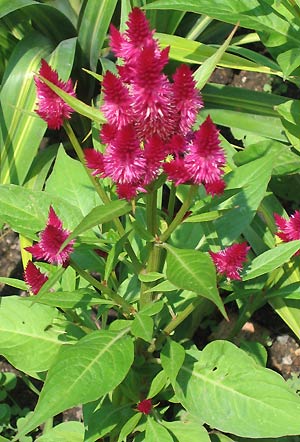 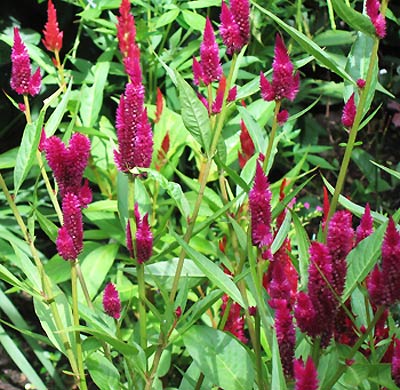 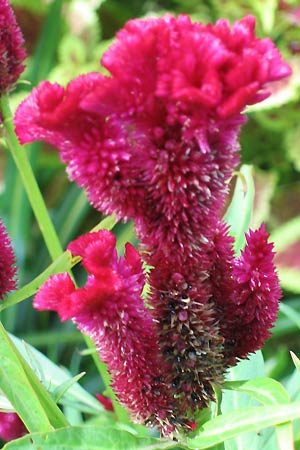 |
||||
|
||||
|
||||
Photographed: In
the Blithewold Garden in Bristol, Rhode Island
2013. |
||||
Coral
Bean, Shrub Coral Bean Erythrina x bidwillii My #5 Vine Mystery was generously solved by Nathaniel, a visitor to the site. I am very grateful for his help. |
||||
|
||||
| Cockspur
Coral Tree, Cry Baby Tree, Sunshine Tree, Fireman's Cap Erythrina
crista-galli This is a peculiarly attractive tree which first caught my eye on a real estate search for a property on Lake Atitlan in Guatemala. That first little tree was very sad though it had an appeal I can't name. I spotted another of these little trees in Argentina, but didn't connect the two. Then as if hit over the head there was one very happy little tree in New Zealand and I connected the dots. Benefits: From: The cockspur coral tree is native the neighboring countries of Argentina, Uruguay, southern Brazil and Paraguay. Planting and Care: This is a small tree growing to a height of no more than 20 feet. In natural settings it likes to grow near ponds, waterways and swamplands. It must be planted in full sun and given adequate moisture, but it won't mind high or low pH soils from sandy to loamy. Warning: The cockspur coral tree is said to have strong narcotic and purgative effects and the seeds are considered poisonous. Text and Photograph ©GreenGardeningCookingCuring.com 2014/2018
|
||||
Photographed: In
the Botanic Garden in Wellington, New Zealand, 2013. |
||||
Photographed: In
the Botanic Garden in Wellington, New Zealand, 2013. |
||||
**Coconut Palm See The "P" Page -- PALM TREES |
||||
| Coconut Palm (Dwarf) See the "P" Page -- PALM TREES | ||||
Comfrey
is a fascinating plant having a long history in medicinal uses
and surprisingly an equally interesting history as a fertilizing
plant. Wikipedia is a very good source of detailed information
on both of the qualities. |
||||
| Common
Horsetail, Rough Horsetail, Scouring Rush, Snake Grass (in South
Africa) Equisetum hyemale Most commonly known as a pond plant, this is an ancient plant on our earth. It will survive almost anything you can throw at it. Benefits: From: North America, Europe, and northern Asia Photographed: In the Japanese Garden in Buenos Aires, Argentina. Planting and Care: Ideally this ancient plant would like to live beside a sunny pond with its feet in the water. If you can give it even a little of that environment it will surely do very well for you. Text ©GreenGardeningCookingCuring.com 2013 |
||||
Community
Gardens The
garden photographed below had another purpose in that it served
as a training ground for students studying
agriculture at nearby colleges. Best of all, the foods these
latter folks grew were given to homeless shelters providing
them with a free source of nutritious fresh foods. |
||||
|
||||
| Copper Leaf (2) See the "J" Page JOSEPHS COAT | ||||
|
||||
**Coralblow See The "F" Page -- FIRECRACKER |
||||
| **Coral Bush See The "J" Page -- JATROPHA | ||||
| **Coral Hibiscus Bush See The "H" Page HIBISCUS -- Coral Hibiscus | ||||
| **Coral Plant See The "F" Page -- FIRECRACKER | ||||
|
||||
|
||||
COREOPSIS |
||||
| Coreopsis,
Pot of Gold, Calliopsis, Tickseed Coreopsis This bright, beautiful, intense yellow flowering plant makes a great summery border in late spring/early summer. It will grow to be about two feet tall. Benefits: Some members of the Coreopsis family have medicinal benefits, but none really stood out. From: The USA Photographed: At the Hotel Atitlan on Lake Atitlan in Guatemala. Planting and Care: This wonderful plant can be a perennial which seems a terrific bonus. If you are planting from seeds, be sure not to bury the seeds in soil. They need sunlight in order to germinate. Once growing in full sun, they are easy to care for if given a little watering during very dry periods. They will have bountiful flowers and more will keep coming if you snip off (dead head) old blossoms. Text and Photographs ©KO 2010 and ©GreenGardeningCookingCuring.com 2018 |
||||
|
||||
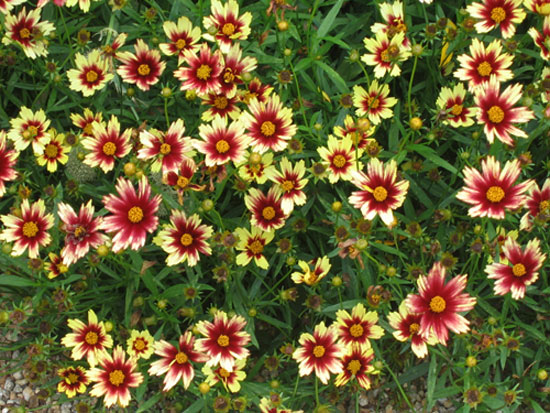 Tickseed Coreopsis 'Redshift' Tickseed Coreopsis 'Redshift'Benefits: From: Photographed: At the Roger Williams Park Botanical Center in Rhode Island in 2013. Planting and Care: Text and Photograph ©GreenGardeningCookingCuring.com 2015/2018 |
||||
**Coriander see "Cilantro" above and Also See The "F" Page -- FITWEED |
||||
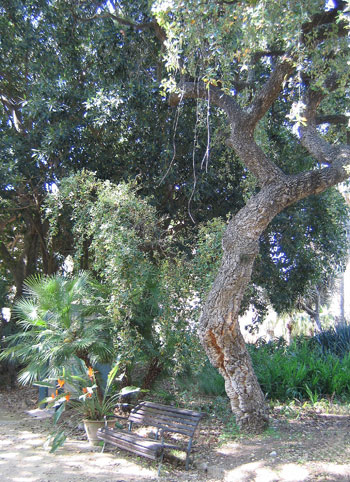 Cork
Oak Tree Quercus suber Cork
Oak Tree Quercus suberThe cork tree is medium sized eventually growing to be about 60 feet tall and it is quite slow to grow, but it will do so for many, many years. Its life expectancy can be 250 years, so it is probably a good thing that it doesn't grow too fast. The tree itself is not spectacularly attractive, but then you will look at the "bark" in total wonder. Benefits: This is the tree that provides us with wine corks, flooring and more. From: Northern Africa, Portugal and Spain Photographed: To the left in the Palermo Botanical Garden in Sicily, Italy. Below are photographs of the bark on a cork tree. I found it fascinating and you may too. Planting and Care: It is said to prefer an acid soil, as do most oaks. If you are serious about growing one from seed, check on your favorite search engine for directions. Trees can be tough to get growing, so if you can buy a small seedling that's probably the way to go. Text and Photograph ©GreenGardeningCookingCuring.com 2012/2018 |
||||
|
||||
Corkscrew
Vine, Caracalla Bean, Climbing Shell Plant, Snail Vine, Snail
Bean, Snail Flower Vigna caracalla |
||||
|
||||
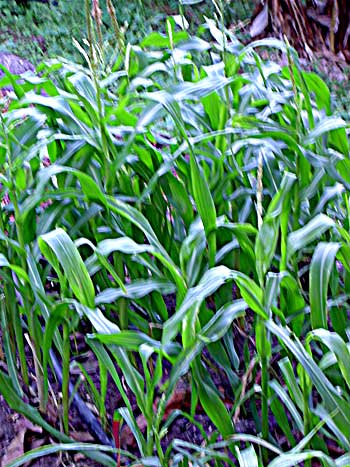 **Corn Zea mays **Corn Zea maysThis is sweet corn, food of the Gods!! In the Caribbean cooked ears of corn are sold by the roadside and we sometimes see a small field of corn growing. As in Mexico, hot weather makes for tough corn, what I've always called "Cow Corn," which grows and is prized in the American southeastern states. It just doesn't equate with the dozens of ears of northern grown sweet corn that I've consumed every summer all of my life. I grew corn in my garden in Washington, D.C., and confirmed my belief that corn is a field crop, meant to grow on acres and acres, not in a dedicated six foot by six foot corner of the backyard garden. We planted sweet corn in our banana garden in Montserrat, but it didn't work out well. Benefits: As all of you know who have eaten sweet corn on the cob, corn is a great source of fiber. But, it also has vision improving antioxidants and a lot of vitamin C. From: Central Mexico Photographed: On the left in our banana garden at our former home in Montserrat and below on hacienda San Buenaventura land by Lake Atitlan in Guatemala. Planting and Care: Corn is a field crop and if you have a field you would be best to talk to someone in the Agriculture Department of your local university or college. They will be able to advise you on seed types all the way through harvesting. Be careful to plant only non-GMO seeds as otherwise you may be very unhappy with the health consequences of not doing so. Text and Photographs Copyrighted ©KO 2008/2010 |
||||
 |
||||
| Corn Plant See the "D" Page -- DRACAENAS -- Corn Plant | ||||
|
||||
|
||||
Photographed: In
the Royal Botanic Garden in Sydney, Australia, in 2013. |
||||
| **Crape Ginger See The "G" Page GINGER -- Spiral Ginger | ||||
Crape Jasmine See the "I" Page -- INDIA CARNATION |
||||
| Crape Myrtle See the "Q" Page -- Queens Crape Myrtle and Crape Myrtle | ||||
**Crepe Ginger See The "G" Page GINGER -- Spiral Ginger |
||||
| **Crepe Myrtle See the "Q" Page -- Queens Crape Myrtle and Crape Myrtle | ||||
| **Crown
of Thorns Euphorbia milii This is a delightful easy to care for orange, red, pink, white or yellow flowering spiny cactus plant I had indoors in New England for years. These are photographs of this plant growing outside. Benefits: The crown of thorns is believed to have many wide ranging health benefits, some of which have been incorporated into 'modern' medicine. From: Madagascar. Planting and Care: The crown of thorns makes a great houseplant, being very forgiving of indoor conditions and maybe even the occasional forgetting of water. Water your plant only when the soil has completely dried and give it a very occasional dose of house plant fertilizer. Set it in a window that gets around 4 hours of sun a day and you'll have a very happy plant. Text and Photographs ©GreenGardeningCookingCuring.com 2012/2013/2018 |
||||
|
||||
|
||||
|
||||
| **Cuban Buttercup See The "Y" Page -- Yellow Alder | ||||
**Cuban Oregano See The "T" Page THYME -- Spanish Thyme |
||||
| **Cuban Royal Palm See The "P" Page PALMS -- Florida Royal Palm | ||||
| **Cuban Thyme See The "T" Page THYME -- Spanish Thyme | ||||
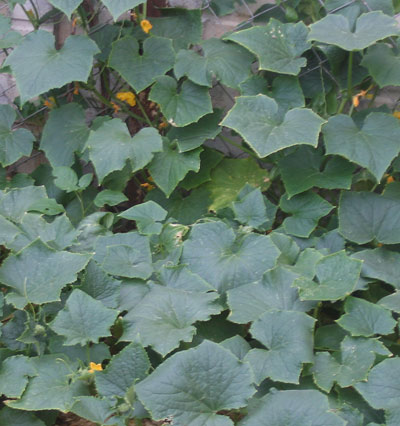 **Cucumbers Cucumis
sativus **Cucumbers Cucumis
sativusWhat is known as a pickling cucumber in the United States is the one most commonly sold in Caribbean food markets all the way from Trinidad & Tobago to Montserrat where we had a home for a decade or so. This plant holds up very well to the strong sun and heat in that part of the world. One year we planted a Chinese variety of cucumber, one of those very long skinny ones with the soft skin. At first they grew well and we had some six inch young cucumbers, but in the end this was not a successful variety in a tropical environment. Benefits: Eat the skin of organic cucumbers for vitamins A and C and the fruit for its sulfur which is beneficial to your skin, hair, and fingernails. From: India Photographed: In our garden at our home at Lake Atitlan in Guatemalan 2014. Planting and Care: In a New England summer time environment, cucumbers of all varieties seemed to grow like weeds. Mound up a bit of good compost rich sweet soil, plant three or four seeds about 1/2 to 1" deep, water and wait for the harvest. In tropical or warm climate gardens they prove a little more difficult. In the Caribbean, we always planted seeds two to a styrofoam cup of good soil. Seeds planted directly in the garden never germinated. At Lake Atitlan where we now live, I have had fair results with cucumbers, but never the bountiful crop I always had in New England. Text and Photograph ©GreenGardeningCookingCuring.com 2014/2018 |
||||
Cumin Cuminum
cyminum |
||||
| Cup and Saucer See CHINESE HAT Above | ||||
| Cup
and Saucer Vine Cobaea scandens This is a new vine in the garden with no photograph as yet. It is very appealing having caught my eye at the local garden shop and, best of all, it is easy to please. From: Tropical Americas including Mexico Planting and Care: This is best considered a tropical vine. It likes full sun and regular rainfall or watering. It will reward your good care with lovely trumpet shaped purple flowers from spring through fall. It will stretch to be between 10 and 20 feet tall and 3 to 6 feet tall. |
||||
| Cup of Gold See the CHALICE VINE Above | ||||
| **Cupid’s Flower See the "M" Page -- MILE A MINUTE | ||||
| Cures and Remedies: | ||||
You'll find 800+ beneficial plants and remedies in "The Lost Book of Herbal Remedies". It includes recipes of tinctures, teas, decoctions, essential oils, syrups, salves, poultices, infusions and many other natural remedies that our grandparents used for centuries. What's also special about this book is that it has between 2 and 4 high definition, color pictures for each plant and detailed identification guidelines to make sure you've got the right plant.
In this wonderful resource you will find: How to treat pain with natural remedies |
||||
Curry |
||||
| **Custard Apple See The "S" Page SOURSOP | ||||
| **Cut Leaf Philodendron See The "P" Page PHILODENDRON -- Cut Leaf Philodendron | ||||
| **Cycad See The "P" Page PALMS -- Cardboard Palm | ||||
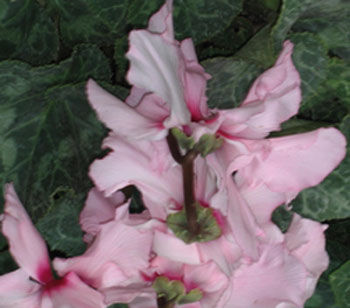 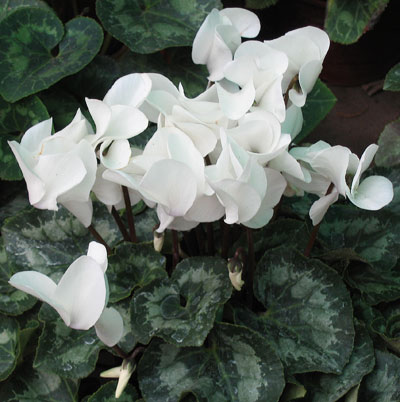 Cyclamen Cyclamen Cyclamen CyclamenBenefits: Despite the poisonous nature of this plant, it has also been used as a curative. I don't recommend threading the line between healing and poisoning. From: Europe and the Mediterranean area all the way to Iran Photographed: In the Japanese Garden in Buenos Aires, Argentina. Planting and Care: These lovely perennials are frequently given as fall and winter holiday plants. That is their best blooming time when the weather is cool and there is more moisture in the air in their native environments. They will bloom for 2 or 3 months and the appear to be in decline and they are. They are preparing for a rest period when the flowers and leaves dry out & die while the tubers below the soil take their rest. When fall arrives begin to water lightly until you see signs of life and you'll be off and running for another few months of flowering. Text and Photographs ©GreenGardeningCookingCuring.com 2013/2018 |
||||
| **Cypress Vine See The "M" Page -- MILE A MINUTE | ||||
|
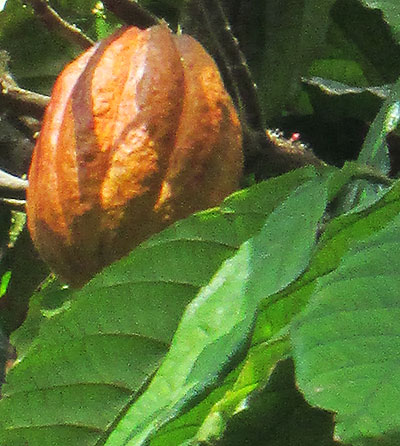
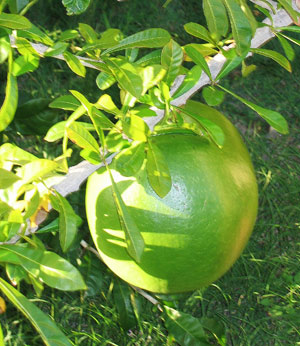
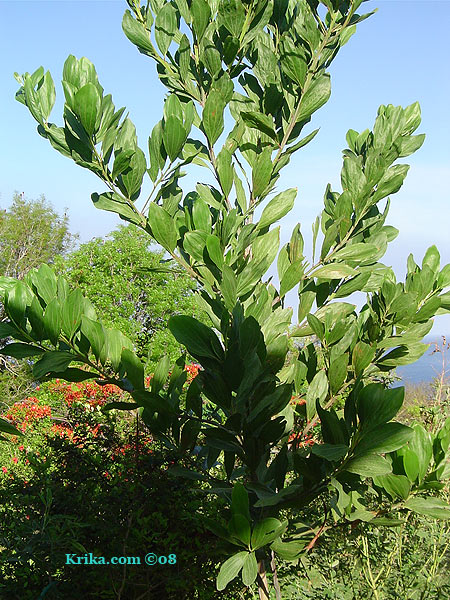
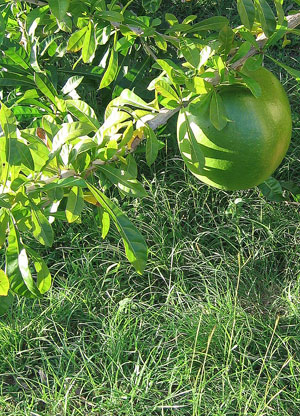
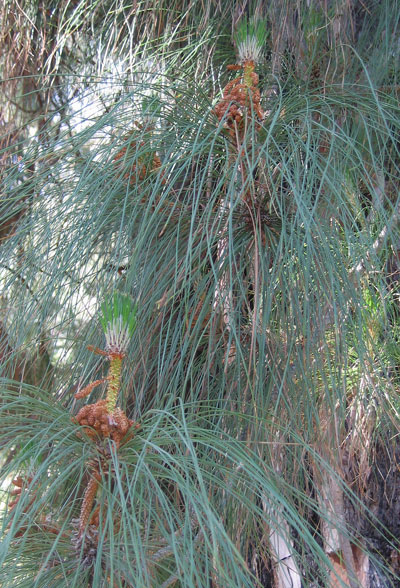
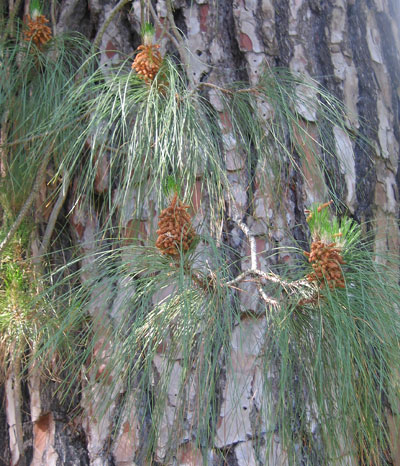
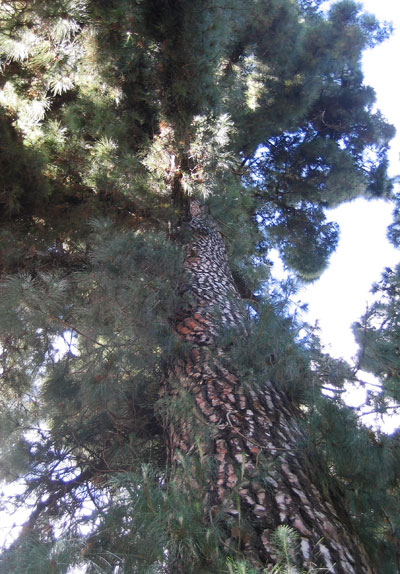
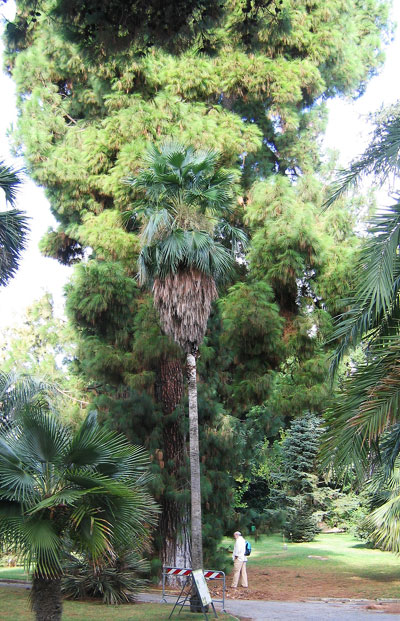
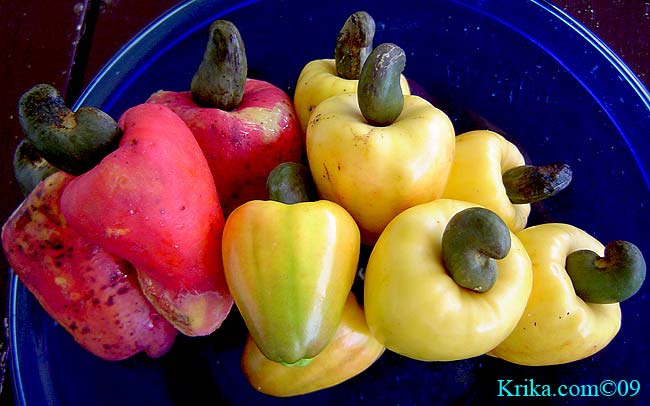
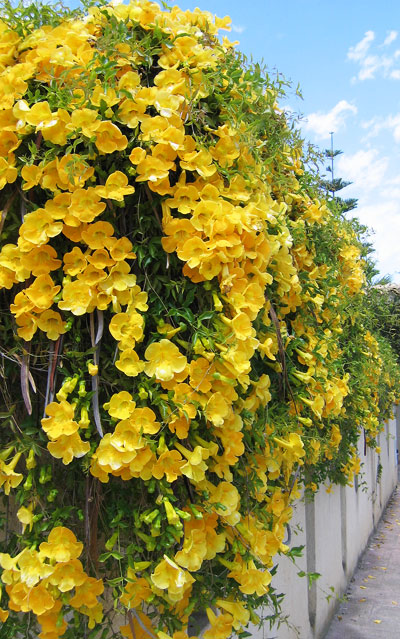
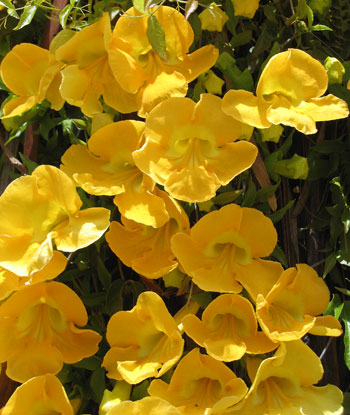

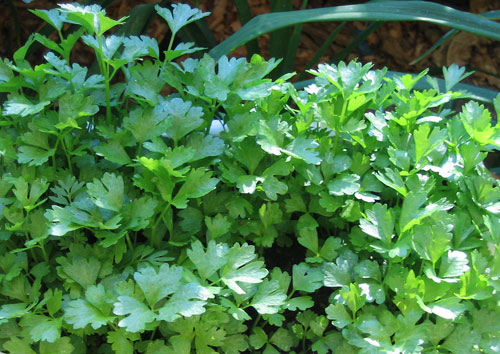
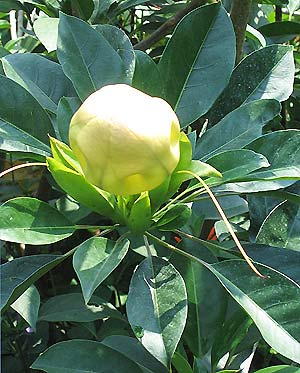
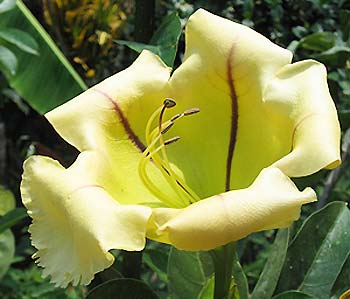
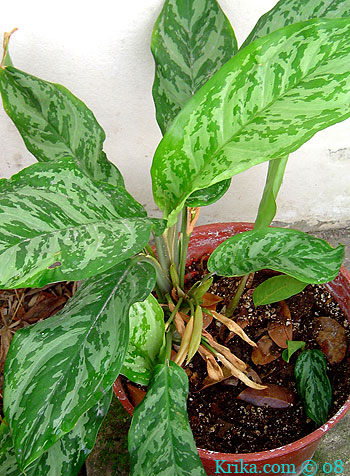
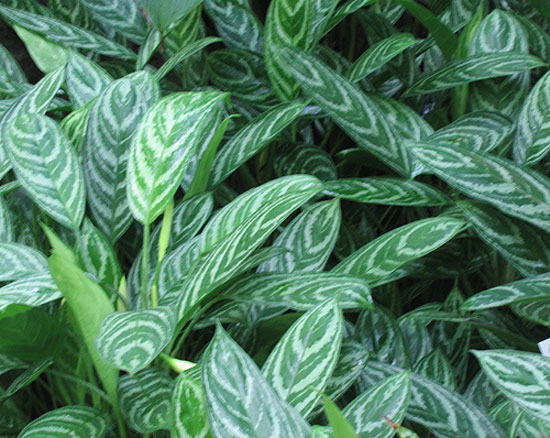
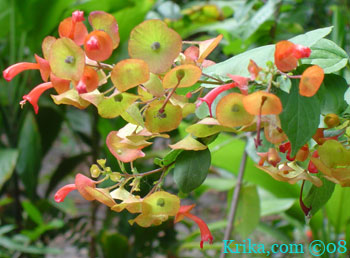
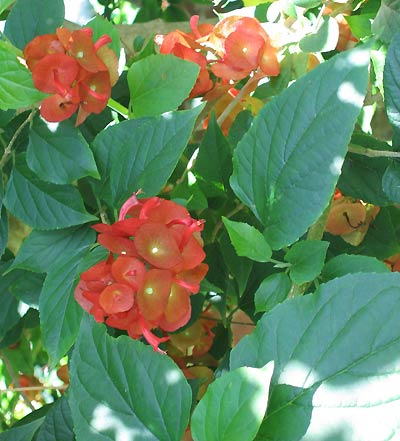
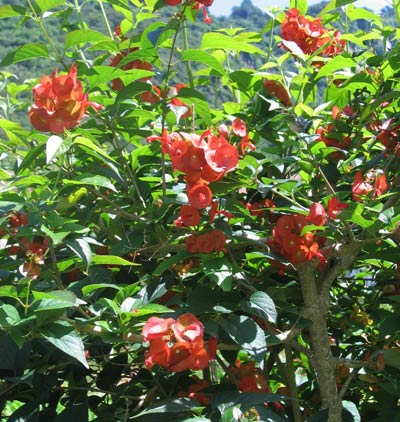
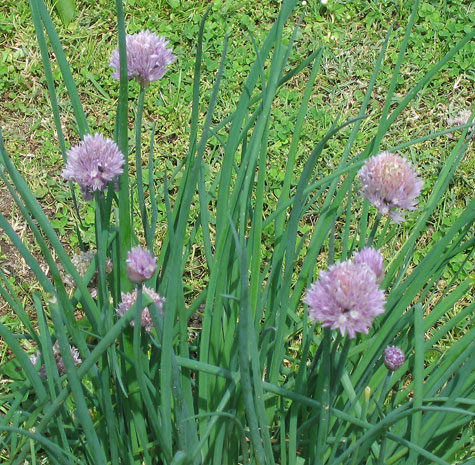

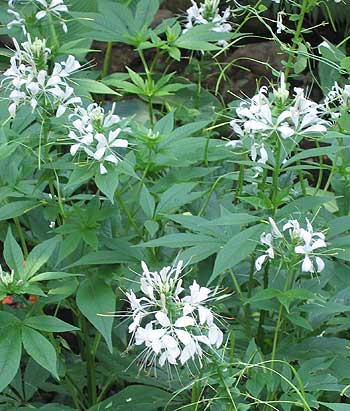
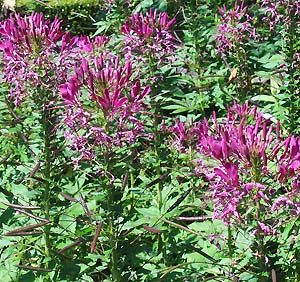
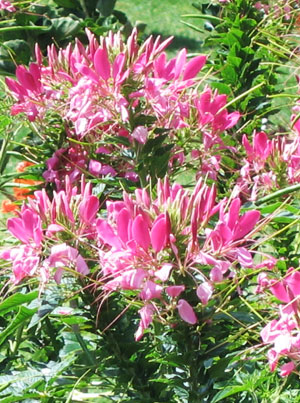
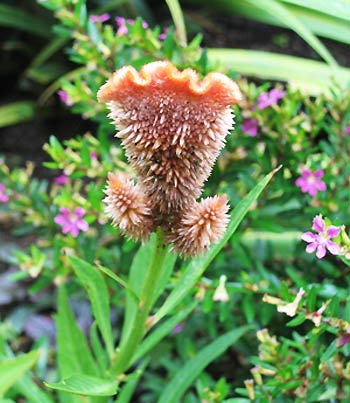
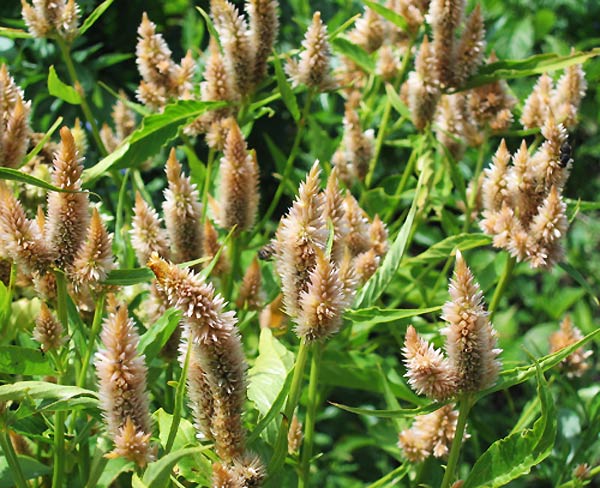
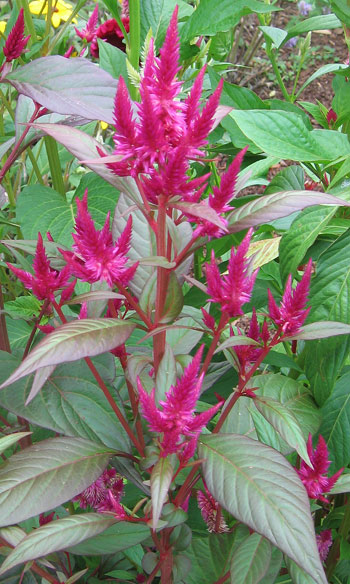
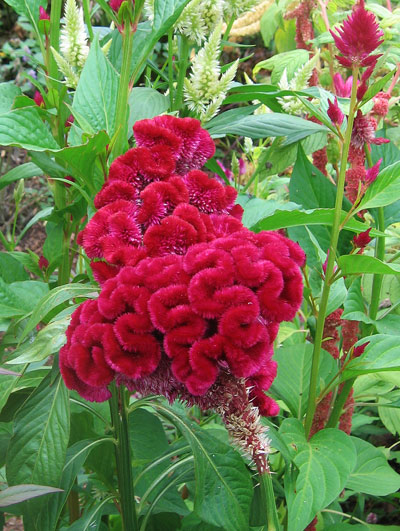
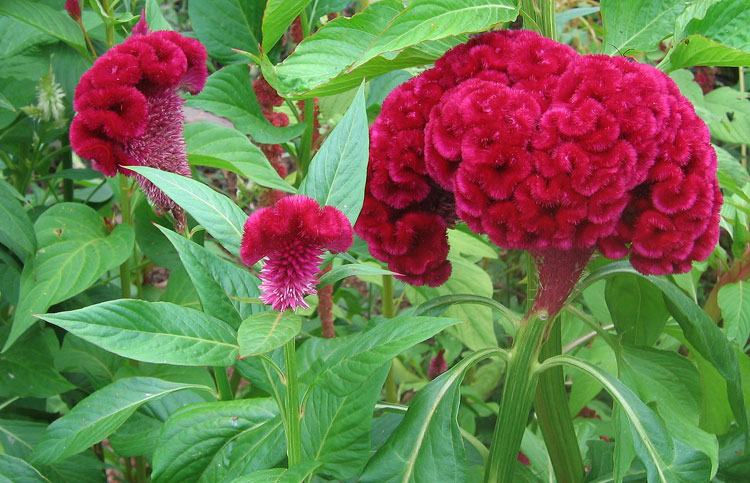
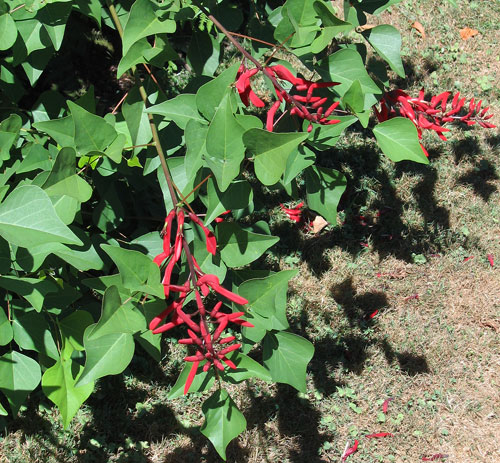
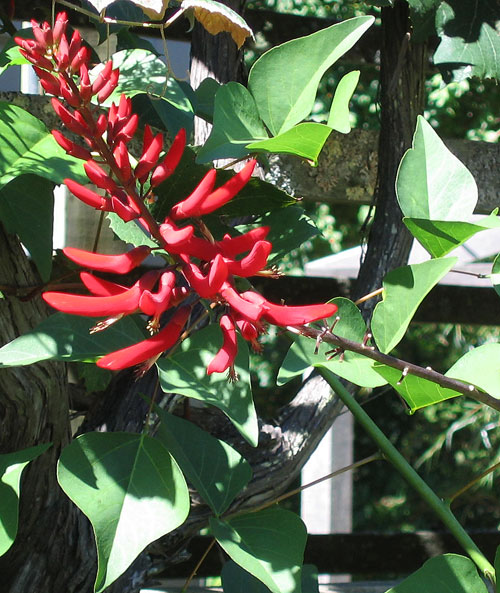
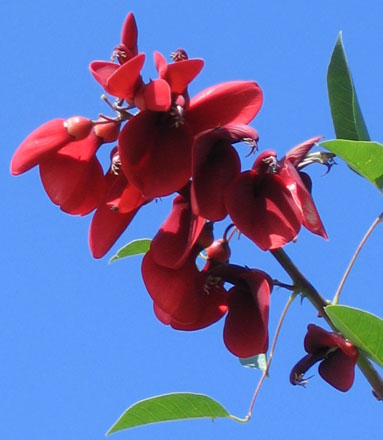
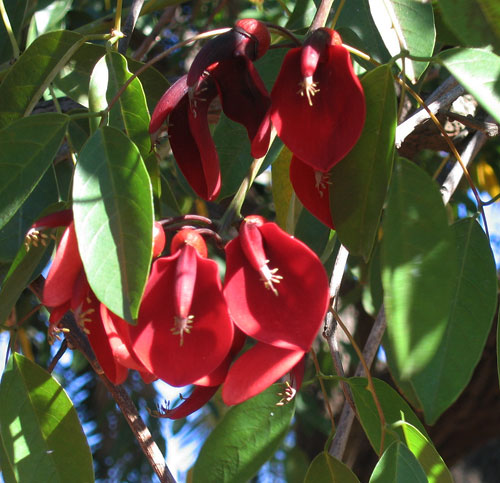
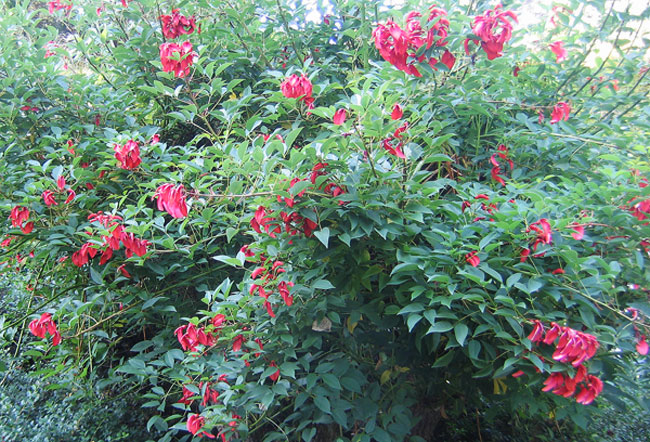
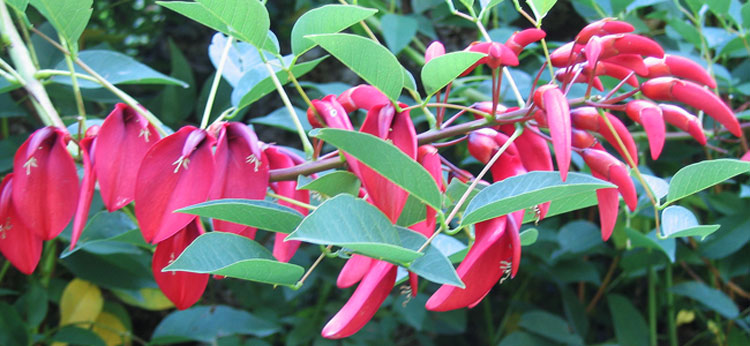
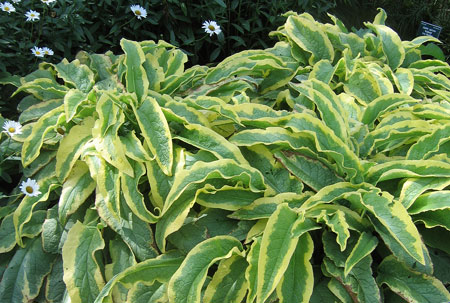 Comfrey
'Axminster Gold', Comfrey Symphytum X uplandicum
Comfrey
'Axminster Gold', Comfrey Symphytum X uplandicum